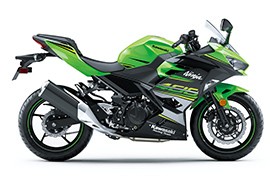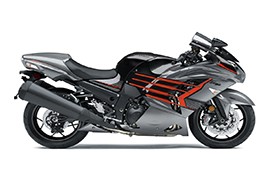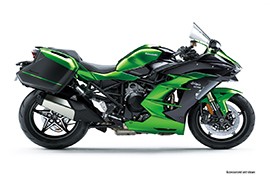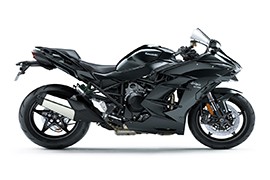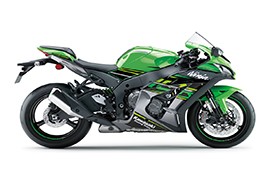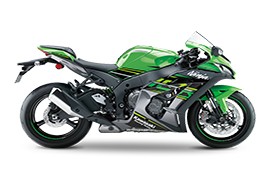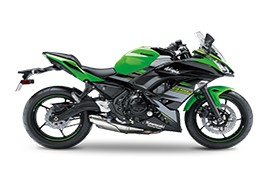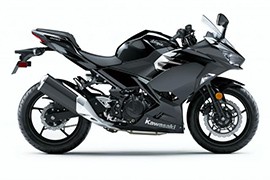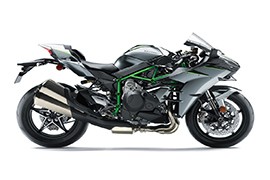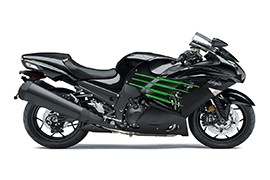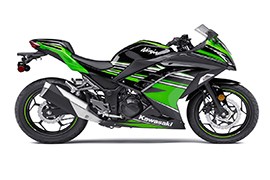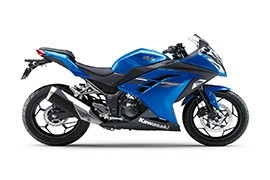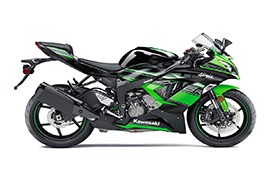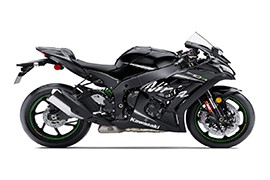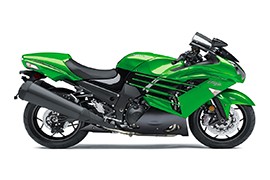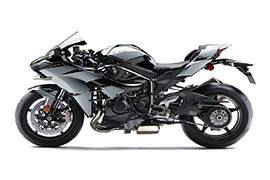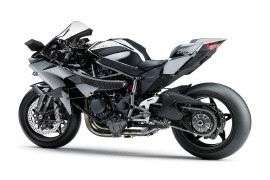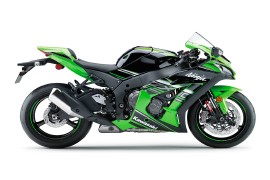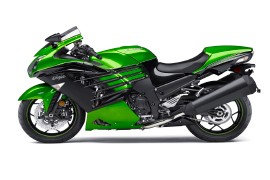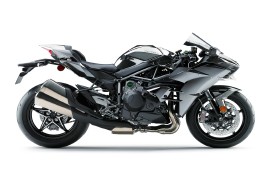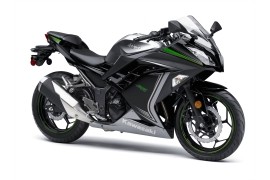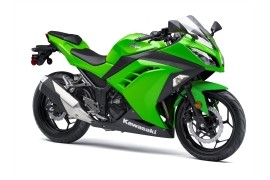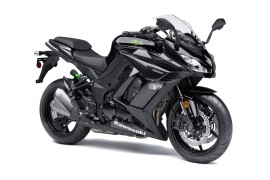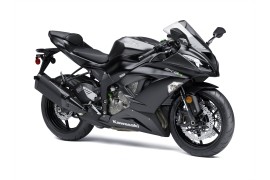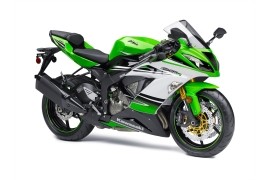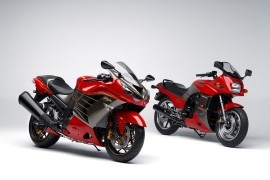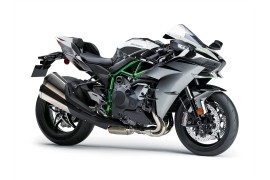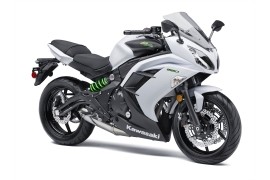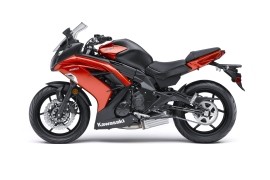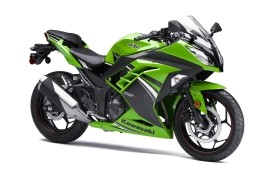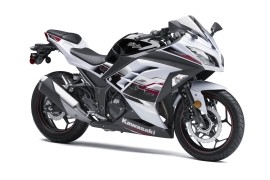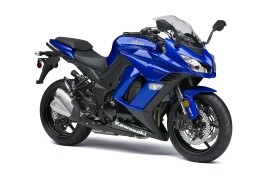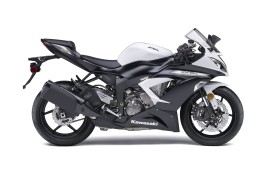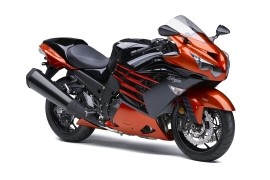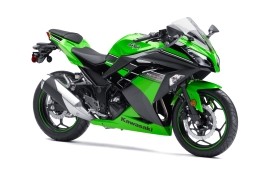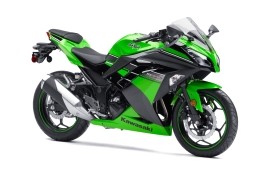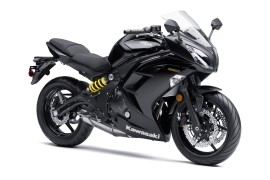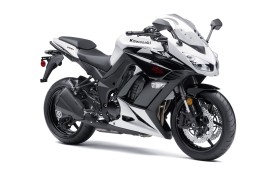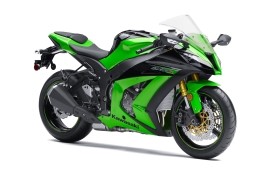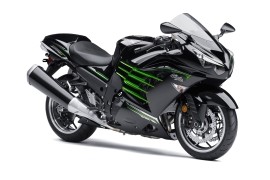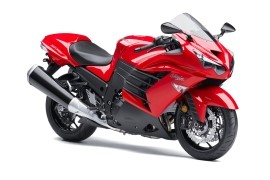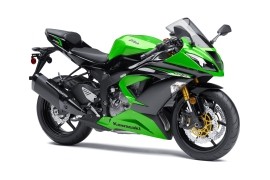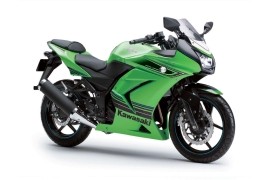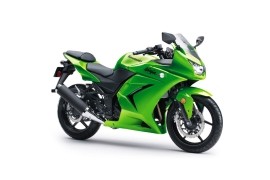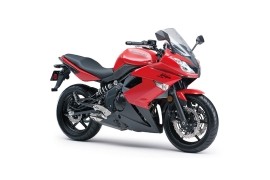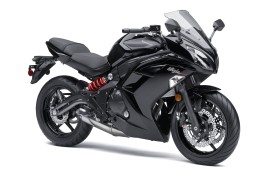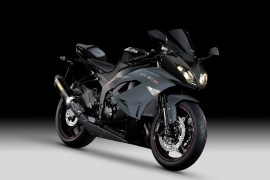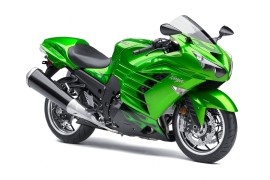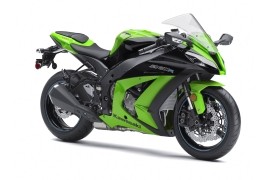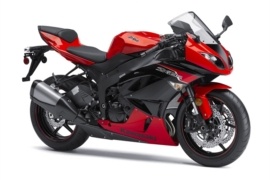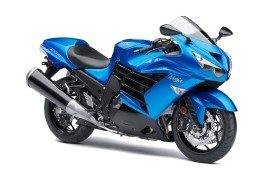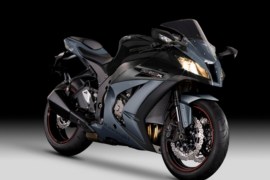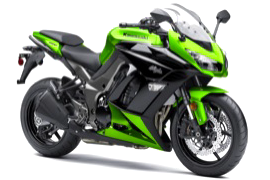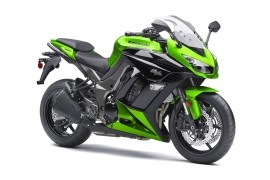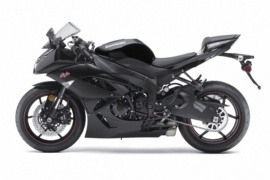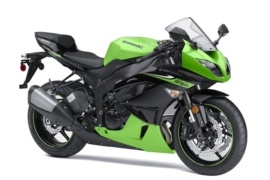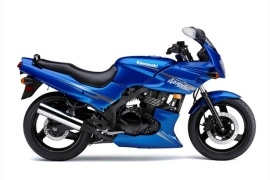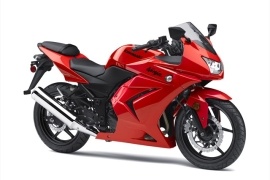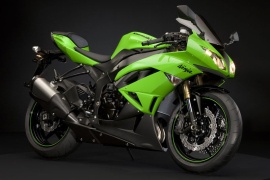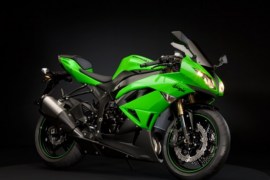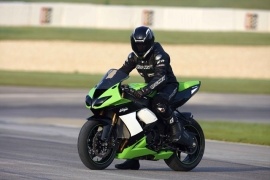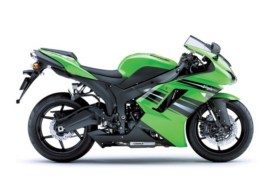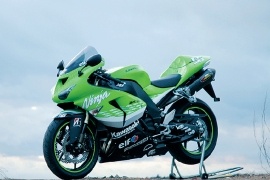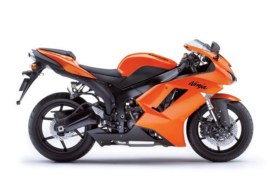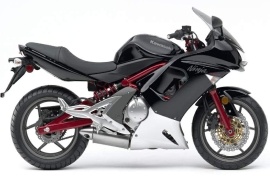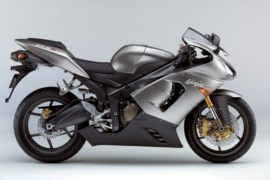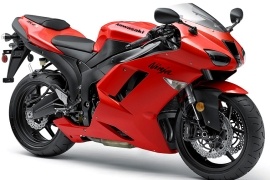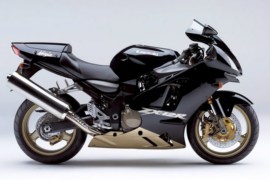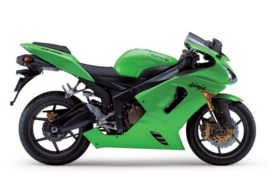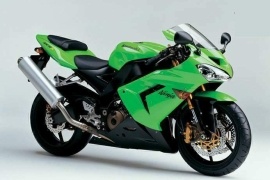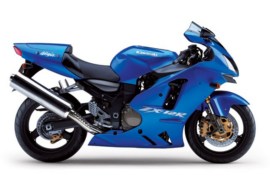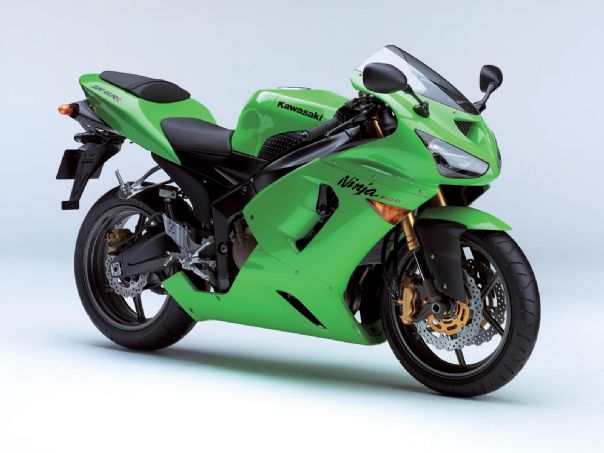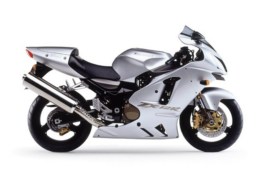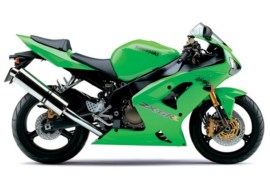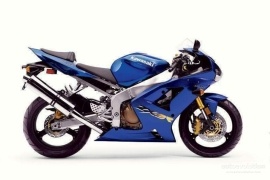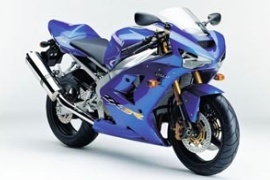KAWASAKI Ninja Models/Series Timeline, Specifications & Photos
First production year: 1995
The Kawasaki Ninja 400 is a sports motorcycle part of the Ninja series in Kawasaki's range. The bike was unveiled at the 2017 Tokyo Motor Show and released in 2018 to replace the Kawasaki 300.
The reason why Kawasaki introduced the Ninja 400 was that the Ninja 300 was struggling with Euro4 emission standards. In addition, the Kawasaki Ninja 400 featured significant modifications to the engine, frame, suspension, and several other parts.
The bike was intended for the global market, while Euro4 compliance suggested it would be good enough for the European market. The bike was launched in the US on December 1, 2017, in February 2018 in Japan, and in April 2018 in India.
In 2018, the Japanese motorcycle manufacturer launched the Kawasaki Ninja 400 KRT Edition, where KRT means Kawasaki Racing Team. The bike offered an exclusive look inspired by the world of superbike racing teams and was available in Lime Green with Ebony at an MSRP of $5,500.
The bike was dressed in an aggressive and aerodynamic bodywork with a dual headlight system, a small windscreen, a two-piece dual seat, a single exhaust system with a silencer mounted on the right side, and five-spoke lightweight wheels.
The 2018 Kawasaki Ninja 400 KRT Edition had installed a 399cc four-stroke parallel-twin liquid-cooled engine underneath its fuel tank, delivering an output power of 49 hp with a peak force at 10,000 rpm and 38 Nm (28 lb-ft) torque at 8,000 rpm.
In 2018, Kawasaki launched the Ninja ZX-14R ABS SE, a motorcycle that continued its reign as the King of Ninja's motorcycle series with its powerful 1,441cc engine that delivered massive amounts of power and torque and smooth power delivery.
The bike's engine performance was intended to be experienced in a raw condition, but Kawasaki installed at the rider’s disposal a series of electronic aids for personal preferences and riding conditions.
The Kawasaki Traction Control (KTRC) system offered three riding modes where mode one and two calculated when traction conditions were about to become unfavorable and acted before any wheel slippage, while mode three featured higher sensitivity and controlled ignition timing, fuel, and air for ultra-smooth operation.
Also, the Power Mode selector allowed the rider to set power characteristics for personal preferences or riding conditions by choosing low power for 70 percent thrust and full power that unleashed the full potential of the massive, powerful engine.
The 2018 Kawasaki Ninja ZX-14R ABS SE model had its heartbeat set by a 1,441cc four-stroke four-cylinder liquid-cooled engine that delivered an output power of 200 hp with a peak at 10,500 rpm, 210 hp with the ram air working at full potential, and 154 Nm (114 lb-ft) of torque at 7,500 rpm.
As for braking performance, the bike featured two 310 mm discs with four-piston calipers on the front wheel and a 250 mm disc with a two-piston caliper on the rear wheel.
For the year 2018, the Japanese motorcycle manufacturer launched the Kawasaki Ninja H2 SX SE, a motorcycle powered by the same 998cc supercharged powerplant found in its superbike sibling but redesigned for more streetability use and less heat.
The bike featured Launch Control Mode (LCM), which provided a good start with minimized wheelspin and front-end lift, activated by a button on the handlebar and active in the first two gears right from the start.
Also, the bike Kawasaki Traction Control (KTRC) combined the traction control technology from the one-mode KTRC that enhanced stability in slippery situations and S-KTRC that maintain optimum traction in sport riding situations by predicting rear wheelspin during acceleration.
In addition, the H2 SX SE featured Electronic Cruise Control that allowed a desired speed to be maintained for more relaxed cruising riding and also reduced the stress on the right hand when traveling long distances.
The 2018 Kawasaki Ninja H2 SX SE had at its core a 998cc four-stroke four-cylinder liquid-cooled supercharged engine that delivered an output power of 197 hp with a peak at 11,000 rpm and 137 Nm (101 lb-ft) of torque available at 9,500 rpm.
As for suspension, the bike packed a 43 mm adjustable inverted fork on the front and a Uni-Trak gas-charged adjustable shock absorber on the rear, while the braking performance was achieved by two 320 mm discs with four-piston calipers on the front wheel and a 250 mm disc with a two-piston caliper on the rear wheel.
In 2018, the Japanese motorcycle manufacturer launched the Ninja H2 SX, a powerful supercharged motorcycle that came with the engine, frame, electronics, and bodywork either heavily revised or new.
In the engine department, Kawasaki aimed for a broader spread of performance without messing with the top-end performance with changes that included new pistons, camshafts, throttle bodies, and a new supercharger.
As for the power figures, the 2018 Kawasaki Ninja H2 SX was powered by a 998cc four-stroke four-cylinder liquid-cooled supercharged engine that delivered less power but more torque than the H2 model with 197 hp with a peak at 11,000 rpm and 137 Nm (101 lb-ft) of torque available at 9,500 rpm.
The SX model featured three-mode traction control and three power level settings, and the possibility to be fitted with some of the SE model features, such as the windscreen, center stand, heated grips, and 12V socket.
For suspension, the bike packed a 43 mm adjustable inverted fork on the front and a gas-charged Uni-Trak piggy-back adjustable shock absorber on the rear.
As for braking performance, the SX model featured two 320 mm discs with four-piston calipers on the front wheel and a 250 mm disc with a two-piston caliper on the rear wheel.
Also, the bike featured an instrument cluster that provided a fuel gauge, dual trip meters, bank angle display, boost pressure, boost temperature, and an economical riding indicator.
In 2018, Kawasaki released the Ninja ZX-10R ABS KRT Edition, a motorcycle developed with feedback from the World Superbike Championship-winning Kawasaki Racing Team and came with a safety feature such as the Anti-lock Braking System (ABS).
The mode featured cutting-edge electronics such as the Inertia Measurement Unit (IMU), Sport-Kawasaki Traction Control (S-KTRC), Kawasaki Launch Control Mode (KLCM), Kawasaki Engine Brake Control (KEBC), Power Mode, and Electronic Steering Damper (ESD).
The Electronic Steering Damper (ESD) was jointly developed with Ohlins, and damping characteristics were electronically changed depending on the bike's speed, acceleration, and deceleration, while also allowing the rider to relax more and reducing fatigue.
The Sport-Kawasaki Traction Control (S-KTRC), with precise management from the IMU unit, allowed riders to choose between five modes for various track conditions and personal preference riding style while also offering an OFF function that completely turned off the system.
As for power, the 2018 Kawasaki Ninja ZX-10R ABS KRT Edition was powered by a 998cc four-stroke four-cylinder liquid-cooled engine that delivered an output power of 200 hp with a peak at 13,000 rpm and 114 Nm (84 lb-ft) of torque available at 11,500 rpm.
For braking performance, the bike featured a Kawasaki Intelligent Braking System (KIBS) with two 330 mm Brembo semi-floating discs coupled to four-piston calipers on the front and a 220 mm disc with a single-piston caliper on the rear.
In 2018, the Japanese motorcycle manufacturer released the Kawasaki Ninja ZX-10R KRT Replica, a motorcycle developed with feedback from the World Superbike Championship-winning Kawasaki Racing Team.
The bike was fitted with cutting-edge electronics such as the Inertia Measurement Unit (IMU), Sport-Kawasaki Traction Control (S-KTRC), Kawasaki Launch Control Mode (KLCM), Kawasaki Engine Brake Control (KEBC), Power Mode, and Electronic Steering Damper (ESD).
The Sport-Kawasaki Traction Control (S-KTRC), with precise management from the IMU unit, allowed riders to choose between five modes for various track conditions and personal preference riding style and an OFF function that turned off the system completely.
The Kawasaki Launch Controle Mode (KLCM) was a system that allowed the riders to optimize acceleration when launching from a stand-still position with the throttle wide open while minimizing wheelspin and front-end lift.
Also, the Power Mode Selector offered three power options, such as mode one with full engine power, mode two with a variable operation that depended on the throttle position, and mode three with low power limited to 50-60 percent of full power.
In the performance department, the 2018 Kawasaki Ninja ZX-10R KRT Replica took its thrust from a 998cc four-stroke four-cylinder liquid-cooled engine that delivered an output power of 200 hp with a peak at 13,000 rpm and 114 Nm (84 lb-ft) of torque available at 11,500 rpm.
In 2018, Kawasaki launched the Ninja 650, a motorcycle that came with a new trellis style frame, a low seat height, and a sporty personality dressed in a sleek, angular bodywork painted in a Pearl Storm Gray with Ebony and Candy Plasma Blue with Ebony color schemes.
The bike replaced the ER6-N and ER6-F, while the biggest change was the trellis frame that replaced the previous perimeter frame and kept the same engine that met the Euro4 regulations for the new model but also retained the underbody exhaust system, Tokico brakes, and banana-shaped swingarm.
In the performance department, the 2018 Kawasaki Ninja 650 delivered strong power with its parallel-twin engine and camshaft profiles tuned for quick response and performance. Also, the exhaust muffler was mounted under the engine for a low center of gravity and weight centralization.
As for the power figures, the 2018 Kawasaki Ninja 650 had at its core a 649cc four-stroke parallel twin-cylinder liquid-cooled engine that delivered an output power of 67 hp with a peak at 8,500 rpm and 66 Nm (48 lb-ft) of torque available at 7,000 rpm.
In addition, the bike featured the Kawasaki Air Management System (KAMS) that directed the hot air from the engine into the ground instead of blowing it to the rider.
For suspension, the bike packed a 41 mm hydraulic telescopic fork on the front and a horizontal Back-link preload adjustable shock absorber on the rear, while the braking power was handled by two 300 mm discs with two-piston calipers on the front and a 220 mm disc with a hydraulic caliper on the rear.
The Japanese motorcycle manufacturer Kawasaki revealed the new Ninja 400 at the 2017 Tokyo Motor Show and launched it in 2018 in Japan as a replacement for the Ninja 300, while in India, it didn't replace the Ninja 300 model, instead, it was sold alongside its smaller sibling.
The bike replaced the Ninja 300 in the Kawasaki lineup and was set to be the new entry-level motorcycle to better compete against bigger bikes like the Yamaha YZF-R3 and KTM RC390, while the major force behind the model was the Euro4 homologation requirements that provided a clean-slate design.
The bike came in a new Ninja styling and delivered better performance than its predecessor thanks to its all-new engine and chassis that were more powerful and lighter but also provided light, predictable handling, and a relaxed, sporty riding position.
Some of the key features installed on the machine were the ERGO-FIT, an interface system that allowed a wide range of riders to feel at one with their bike, the Anti-lock Braking System (ABS), Assist and Slipper Clutch that acted as a back-torque limiter and a self-servo mechanism for a lighter clutch lever pull, and an Economical Riding Indicator that popped out on the instrument panel when favorable fuel consumption was achieved.
In the performance department, the 2018 Kawasaki Ninja 400 had at its core a 399cc four-stroke four-cylinder liquid-cooled engine that delivered an output power of 49 hp with a peak at 10,000 rpm and 38 Nm (28 lb-ft) of torque available at 8,000 rpm.
The Kawasaki Ninja H2 was a street-legal version of the H2R model, which shared many components, such as the 998cc engine, the supercharger, the trellis frame, aerodynamic bodywork, single-sided swingarm, powerful Brembo brakes, and compact superbike dimensions.
The bike featured a supercharger that fed the engine with cool, pressurized air, was designed to allow high-efficiency operation over a wide range of conditions and didn't require a large, heavy intercooler to cool the compressed air.
In 2018, the Japanese motorcycle manufacturer released the Kawasaki Ninja H2 Carbon, a limited-release street-legal production motorcycle available only in select markets and for a short period of time.
The bike featured a 998cc engine designed to handle stress better than a same-size aspirated engine and featured cast pistons instead of forged ones that provided better strength and handled the high temperature generated by the supercharged engine much better.
As or the power figures, the 2018 Kawasaki Ninja H2 Carbon took its thrust from a 998cc four-stroke four-cylinder liquid-cooled supercharged engine that delivered an output power of 200 hp with a peak at 12,500 rpm and 133 Nm (98 lb-ft) of torque available at 10,500 rpm.
The braking system matched the performance of the bike with two 330 mm Brembo discs and four-piston Brembo calipers on the front and a 250 mm disc squeezed by a two-piston Brembo caliper on the rear.
In 2018, the Japanese motorcycle manufacturer released the Kawaski Ninja ZX-14R ABS, the flagship model of Kawasaki's lineup that delivered a lot of horsepowers and smooth power delivery topped by advanced technologies such as ABS and traction control.
The ABS version was capable of riding two-up on back roads and wrinkling the asphalt on track while dressed in Emerald Blazed Green with Metallic Carbon Gray and Pearl Storm Gray with Ebony and Candytone Orange color schemes.
The bike featured a central ram air duct that offered a straighter path to the airbox, which directed cooler, high-pressure air from the front fairing, for maximum power output.
In the power department, the 2018 Kawasaki Ninja ZX-14R ABS motorcycle took its thrust from a 1,441cc four-stroke four-cylinder liquid-cooled engine that delivered an output power of 200 hp with a peak at 10,500 rpm, 210 hp with the ram air working at full potential, and 154 Nm (114 lb-ft) of torque at 7,500 rpm.
For suspension, the model packed a 43 mm 18-way compression and 15-way rebound adjustable inverted fork on the front and a bottom-link Uni-Trak adjustable gas-charged shock absorber on the rear.
As for braking performance, the bike featured two 310 mm discs with four-piston calipers on the front wheel and a 250 mm disc with a two-piston caliper on the rear wheel.
In 2017, the Japanese motorcycle manufacturer launched the Ninja 300 ABS KRT Edition, a motorcycle that packed many of the same performance features as larger Ninja models, such as a digital fuel injection system and an F.C.C. slipper assist clutch that reduced lever effort of up to 25 percent.
The bike was propelled by a lightweight, compact, and potent engine matched by a chassis with nimble handling and balanced suspension that offered a smooth ride but also fitted with the latest available technology.
Also, the bike rolled on a set of 10-spoke wheels with a sleek appearance, a six-speed manual transmission with a roller-type shift drum for smooth operation and strong gears for durability, and a Kawasaki Air Management System (KAMS) that featured a special deflector in the back of the radiator to direct the air underneath the motorcycle instead of blowing it to the rider.
The 2017 Kawasaki Ninja ABS KRT Edition took its thrust from a 296cc four-stroke parallel twin-cylinder liquid-cooled engine that delivered an output power of 39 hp with a peak at 11,000 rpm and 27 Nm (20 lb-ft) of torque available at 10,000 rpm.
For braking performance, the bike packed a single 290 mm petal disc with a two-piston caliper on the front and a 220 mm petal disc squeezed by a two-piston caliper on the rear, coupled to a Nissin ABS unit that came in a small and compact package.
The Kawasaki Ninja 300 ABS was launched in 2017 by the Japanese motorcycle manufacturer Kawasaki, a lightweight motorcycle that featured a 296cc engine, excellent performance, and effortless handling characteristics.
The Ninja name implied that the bike was fitted with all the best that Kawasaki had to offer, either engine performance, chassis performance, or the latest technology available at the time, which resulted in a power and torque delivery that placed it at the top of its class.
The bike featured similar styling to the Kawasaki flagship Ninja sports bike models and returned for 2017 as an ideal lightweight sports bike for various riders, with its natural upright seating position, comfortable ergonomics, lightweight handling, and nimble response.
Also, the Ninja 300 was one of the most fuel-efficient motorcycles in the Kawasaki range, with its parallel twin engine fed by a digital fuel injection system and lightweight pistons that boosted performance and delivered a strong low-mid range of torque.
As for performance, the 2017 Kawasaki Ninja 300 ABS had at its core a 296cc four-stroke parallel twin-cylinder liquid-cooled engine that delivered an output power of 39 hp with a peak at 11,000 rpm and 27 Nm (20 lb-ft) of torque available at 10,000 rpm.
In addition, the bike featured large vents in the fairings for optimal heat management, a slim seat that allowed the rider an easier reach to the ground, aluminum footpegs, a ZX-6R dual multi-reflector headlight design, and a set of ten-spoke wheels.
The Kawasaki Ninja ZX-6R was a motorcycle in the Ninja series made by the Japanese motorcycle manufacturer Kawasaki, first introduced in 1995 and constantly upgraded throughout the years as a response to new products of its rivals such as Honda, Yamaha, and Suzuki.
With strong competition from Honda's CBR600F4I, Suzuki's GSX-600R, and Yamaha's YZF-R6, Kawasaki made an unusual move in late 2002 by bumping the capacity of the traditional 600cc engine to a displacement of 636cc.
Over the years, in 2017, Kawasaki launched the Ninja ZX-6R ABS KRT Edition, a motorcycle loaded with high technology features such as the Kawasaki Traction Control (KTRC) system, Power Mode Selector, and Kawasaki Intelligent Braking System (KIBS).
The Kawasaki Traction Control (KTRC) system combined the best features from the Ninja ZX-10R S-KTRC system and from the Concours 14 that provided maximum traction control within three available modes. Mode one and two controlled the ignition timing with complex analysis that predicted when traction conditions were about to become unfavorable, and mode three featured higher sensitivity for ultra-smooth operation.
In the performance department, the 2017 Kawasaki Ninja ZX-6R ABS KRT Edition was brought to life by a 636cc four-stroke four-cylinder liquid-cooled engine that delivered an output power of 131 hp with a peak at 13,500 rpm and 71 Nm (52 lb-ft) of torque available at 11,500 rpm.
In 2017, the Japanese motorcycle manufacturer launched the Kawasaki Ninja ZX-10RR, a motorcycle that featured more engineering advantages from the world-class racing team and came in a faster, stronger, and more race-focused package than the ZX-10R.
Some of the differences between the ZX-10RR and ZX-10R included the paint scheme, where the RR featured the Winter Edition livery inspired by the company's WSBK team with a snowflake on the rear cowl and windshield and the RR logo embedded into the cover of the engine and a new key with the RR badge.
The bike was powered by a similar 999cc engine, with 200 hp on the clock but with a few modifications to accommodate the high-lift cams, with DLC-coated tappets for reduced friction and stiffer valve springs.
Another difference included the seven-spoke Marchesini wheels that came in a lighter package for reduced weight and improved handling dressed in a set of super-sticky Pirelli Supercorsa SP tires that improved cornering grip, which allowed the bike to go faster around corners.
Also, the suspension setup was revised to suit the single-seater motorcycle and the Pirelli tires, but also Kawasaki claimed that the RR delivered smoother weight transfer and less pitch than the standard model, which gave the rider confidence to ride faster on the track.
The 2017 Kawasaki Ninja ZX-10RR featured the same wind tunnel-developed bodywork as its 10R brother but with more race-focused touches, such as the RR designation throughout the bike and the rear seat, replaced by an aerodynamic seat cover.
In 2017, Kawasaki launched the Ninja ZX-14R ABS SE, an ultra-powerful motorcycle powered by a massive 1,441cc engine and fitted with advanced electronics, all incorporated in an innovative monocoque frame with stunning bodywork design that put the bike at the top of its class.
For 2017, the Kawasaki Ninja ZX-14R ABS SE returned with Brembo brakes, Kawasaki Traction Control (KTRC) system, and a new color scheme such as the Metallic Spark Black with Golden Blazed Green.
The Kawasaki Traction Control (KTRC) system offered three riding modes where mode one and two calculated when traction conditions were about to become unfavorable and acted before any wheel slippage, while mode three featured higher sensitivity and controlled ignition timing, fuel, and air for ultra-smooth operation.
Also, the bike featured a wind tunnel-designed bodywork with an aggressive front cowl with a unique four-headlight design, a standard single seat cover, an aggressive tail design, and fairings that improved radiator air flow combined with a heat guard mounted on the exhaust pipe that reduced heat reaching to the rider.
As for power, the 2017 Kawasaki Ninja ZX-14R ABS SE model had its heartbeat set by a 1,441cc four-stroke four-cylinder liquid-cooled engine that delivered an output power of 200 hp with a peak at 10,500 rpm and 154 Nm (113 lb-ft) of torque available at 7,500 rpm.
The Kawasaki Ninja H2, released by the Japanese motorcycle manufacturer in 2017, was a supercharged street bike that delivered unprecedented power and remarkable acceleration in a street-legal package, unlike its racetrack-only H2R brother.
The H2 model was developed as the ultimate performance street-legal machine and built with state-of-the-art technologies combined by Kawasaki's high-performance motorcycle, aerospace, and gas turbine divisions.
The engine had to be compact with high horsepower on tap and intense acceleration, so Kawasaki engineering divisions created a highly-efficient supercharger that didn't require an intercooler to cool down the air fed to the engine.
In the performance department, the 2017 Kawasaki Ninja H2 had its soul in a 998cc four-stroke four-cylinder liquid-cooled supercharged engine that delivered an output power of 200 hp with a peak at 12,500 rpm and 133 Nm (98 lb-ft) 10,500 rpm.
The bike featured a digital fuel injection system that provided smooth engine response and enhanced the input to the Sports Kawasaki Traction Control (S-KTRC) system, which accommodated the Kawasaki Launch Control Mode, and Kawasaki Engine Brake Control features.
For braking performance, the H2 model packed 330 mm discs clamped by a couple of four-piston Brembo calipers on the front wheel and a 250 mm disc squeezed by a two-piston Brembo caliper on the rear.
In 2017, the Japanese motorcycle manufacturer launched the Kawasaki Ninja H2R, a flame-spitting machine, and an engineering marvel manufactured using only technological expertise from multiple divisions of Kawasaki Heavy Industries.
Kawasaki wanted to create a factory-built machine where the engineers pursued unadulterated performance without worrying about the limitations of street homologation and came up with a supercharged four-stroke engined motorcycle that delivered out-of-this-world power for a factory-built super machine.
Also, Kawasaki manufactured the H2 machine, which was a street-legal version of the H2R that was made using the same technology from the H2R but tuned in a way that matched the street-legal homologation.
The H2R and H2 models shared many technologically advanced components, such as the 998cc engine, the supercharger, the trellis frame, the aerodynamic bodywork, the single-sided swingarm mounted to the engine, powerful Brembo brakes, and much more.
As for the immense power, the 2017 Kawasaki Ninja H2R squeezed everything it could from the 998cc four-stroke four-cylinder liquid-cooled supercharged engine and delivered an output power of 310 hp with a peak at 14,000 rpm and 165 Nm (122 lb-ft) of torque available at 12,500 rpm.
To match the massive power, the Kawasaki H2R packed a massive 330 mm Brembo semi-floating disc with a Brembo M50 four-piston caliper on the front wheel and a 250 mm disc at the rear that provided strong braking performance.
In 2016, the Kawasaki Racing Team and Kawasaki factory in Japan joined forces and created the new ZX-10R motorcycle that featured world-class power and championship-proven technology, which brought the performance to the next level with its new engine, chassis, and top-end electronic package.
The 2016 Kawasaki Ninja ZX-10R ABS KRT Edition was tested, refined, and approved by the World Champion's Jonathan Rea and Tom Sykes, which brought the bike as close as it could to being part of the Kawasaki World Superbike team.
The bike featured a new, more powerful engine with a lighter crankshaft that provided increased low-mid range power, new pistons for better engine response, a new computer-controlled electronic throttle valve that delivered precise control, a new lightweight titanium exhaust system, and much more.
The ABS KRT Edition motorcycle had its soul in a 998cc four-stroke four-cylinder liquid-cooled engine that delivered an output power of 200 hp with a peak at 13,000 rpm, 210 hp with the ram air system at full potential, and 114 Nm (84 lb-ft) of torque available at 11,600 rpm.
Also, the model featured a new Sports Kawasaki Traction Control system that offered five riding modes, such as the mode one and two designed for track purposes, mode three was for a dry circuit with grippy tires, mode four was for dry canyon roads or commuting, and mode five was programmed for wet circuit or street use.
The Kawasaki Ninja ZX-14 was introduced in 2005 at the Tokyo Motor Show and released in 2006 as the most powerful motorcycle in the Ninja sport bike series and also as a replacement for the Kawasaki ZZ-R1200.
The bike was capable of accelerating from 0-96 kph (0-60 mph) in only 2,5 seconds, while the top speed was electronically limited to 299 kph (186 mph) as a result of an agreement between the major Japanese and European motorcycle manufacturers.
Over the years, the bike featured minor updates and a second-generation revision in 2012 when Kawasaki added the R suffix to its name along with a displacement increase for more power and two variable power modes, The Kawasaki Traction Control (KTRC) and an ignition management system borrowed from the ZX-10R.
Also, for the first time, the bike featured a slipper clutch along with cosmetic updates, chassis upgrades, and revised suspension internals.
In 2016, the Japanese motorcycle manufacturer launched the Kawasaki ZX-14R ABS, an ultra-powerful motorcycle with a 1,441cc engine along with advanced electronics, an innovative monocoque frame, and aggressive bodywork that placed it at the top of its class with a real head-turner effect.
The 2016 Kawasaki Ninja ZX-14R ABS had at its core a 1,441cc four-stroke four-cylinder liquid-cooled engine that delivered an output power of 200 hp with a peak at 10,500 rpm and 154 Nm (113 lb-ft) of torque available at 7,500 rpm.
In 2016, the Japanese motorcycle manufacturer released the Kawasaki Ninja H2, the street-legal version of the H2R model, which shared many components, such as the 998cc engine, the supercharger, the trellis frame, aerodynamic bodywork, single-sided swingarm, powerful Brembo brakes, and compact superbike dimensions.
For the 2016 H2 model, the manufacturer introduced a new assist and slipper clutch system that made the lever pressure 40 percent lighter with less fatigue on longer journeys and also prevented rear wheel-hop on aggressive downshifts.
Both models were available in Mirror Coated Spark Black, which was a revised silver-mirror paint with glass flakes in the first clear coat to catch the light for a high-quality style appearance.
The supercharger that fed the engine with pressurized cool air was designed to allow high-efficiency operation over a wide range of conditions and didn't require the use of a large, heavy intercooler to cool the compressed air.
In the performance department, the street-legal 2016 Kawasaki Ninja H2 had at its core a 998cc four-stroke four-cylinder liquid-cooled supercharged engine that delivered an output power of 200 hp with a peak at 11,000 rpm and 134 Nm (99 lb-ft) of torque available at 13,600 rpm.
As for braking performance, the bike packed two 330 mm discs with opposed four-piston calipers on the front wheel and a 250 mm disc squeezed by a two-piston caliper on the rear wheel.
In 2015, the Japanese motorcycle manufacturer launched the Ninja 300 Special Edition motorcycle that returned with new colors, graphics, and sporty Dunlop tires, while also continuing to offer the ideal entry point for beginners riders, track-day enthusiasts, commuters, and riders of all sizes.
In other technical and performance departments, the Special Edition model featured the same specifications as the 2015 standard model, such as the digital fuel injection engine, low and tapered seats, Ninja sportbike bodywork design, new Dunlop TT900 GP tires, and updated color and graphics for 2015.
The bike featured a high-tensile frame that offered optimum rigidity, feels, and agility at both high and low speeds coupled to a beefy swingarm that contributed to the frame rigidity and achieved an optimal balance of chassis stiffness.
In the visual department, the model featured an aggressive bodywork design with a modern floating windscreen that reduced turbulence, two helmet holders located under the rear seat, and a new color scheme such as Metallic Moondust Gray with Ebony.
As for power, the 2015 Kawasaki Ninja Special Edition was powered by a 296cc four-stroke parallel twin-cylinder liquid-cooled engine that delivered an output power of 39 hp with a peak at 11,000 rpm and 27 Nm (20 lb-ft) of torque available at 10,000 rpm.
In addition, the bike was available with Genuine Kawasaki Accessories such as a color-matched seat cowl, three optional gel seats for additional comfort, a tank bag and a soft top case, a tall windscreen, and engine guards.
In 2015, the Japanese motorcycle manufacturer launched the Ninja 300, a bike that packed many of the same performance features found on larger Ninja models, such as a digital fuel injection system and an F.C.C. slipper assist clutch that reduced lever effort of up to 25 percent.
Some of the key features packed on the bike included the low seat height with tapered seats that boosted confidence for smaller riders, a sportbike bodywork with an aggressive design that set the bike apart from its lightweight competitors, and a high-tensile frame that offered optimum flex with excellent feel and agility.
Also, the bike rolled on a set of 10-spoke sportbike wheels with a sleek appearance, a six-speed manual transmission with a roller-type shift drum for smooth operation and strong gears for durability, and a Kawasaki Air Management System (KAMS) that featured a special deflector in the back of the radiator to channel the air underneath the motorcycle instead of blowing it to the rider.
In the performance department, the 2015 Kawasaki Ninja 300 had its heartbeat set by a 296cc four-stroke parallel twin-cylinder liquid-cooled engine that delivered an output power of 39 hp with a peak at 11,000 rpm and 27 Nm (20 lb-ft) of torque available at 10,000 rpm.
In addition, the bike was available with Genuine Kawasaki Accessories such as a color-matched seat cowl, three optional gel seats for additional comfort, a tank bag and a soft top case, a tall windscreen, and engine guards.
In 2015, Kawasaki released the Ninja 1000 ABS, a motorcycle fitted with the most advanced features at the time, such as a 1,043cc engine that feature two selectable power modes and Kawasaki Traction Control (KTRC) system, with three available modes that ensured the most optimum power delivery in all conditions.
One of the most stunning aspects of the 2015 Ninja 1000 ABS was the bodywork inspired by the race-ready ZX-6R and ZX-10R machines, which offered an edgy look with great aerodynamics and stability at high speeds. In addition, the bodywork came with two new colors for 2015, such as Candy Lime Green with Metallic Spark Black and Metallic Carbon Gray with Metallic Spark Black.
Also, the bike offered comfortable ergonomics with its handlebar-mounted higher than on race-oriented bikes and lower mounted footpegs, which resulted in a comfortable seating position making the bike a capable sport-tourer, while still remaining a sports bike.
The model packed a lightweight and rigid aluminum backbone frame with a similar concept as the ZX-10R motorcycle and used the engine as a stressed member while offering a narrow and easy-to-grip design for maximum rider comfort and feedback.
In the performance department, the 2015 Kawasaki Ninja 1000 ABS packed a 1,043cc four-stroke four-cylinder liquid-cooled engine that provided an output power of 138 hp at 9,600 rpm and 110 Nm (81 lb-ft) of torque at 7,800 rpm.
In 2015, the Japanese motorcycle manufacturer released the Kawasaki Ninja ZX-6R, a sports middleweight machine available only for the US market, which featured a 636cc engine coupled to a six-speed manual transmission that ensured a smooth and racing power delivery to the rear wheel.
On the tech side, the bike came with the best Kawasaki advanced technology, such as the three-mode Kawasaki Traction Control (K-TRC) system that offered three available modes to suit the rider’s personal performance preferences or various riding conditions.
Mode one offered maximum racetrack performance, mode two delivered sporty street performance, and mode three eliminated wheelspin while improving riding on slippery conditions. Also, the riders had the choice to completely turn off the system for total manual control.
For suspension, the model packed a 41 mm adjustable inverted Showa BP-SFF fork on the front and a bottom-link Uni-Trak fully adjustable spring-preload shock absorber on the rear.
As for braking performance, the bike featured two 310 mm petal discs with radial-mount four-piston Nissin calipers on the front and a 220 mm petal disc with a single-piston caliper on the rear.
In the power department, the 2015 Kawasaki Ninja ZX-6R was powered by a 636cc four-stroke four-cylinder liquid-cooled engine that delivered an output power of 131 hp with a peak at 13.500 rpm and 71 Nm (52 lb-ft) of torque available at 11,500 rpm.
In addition, the bike was available with a complete line of Genuine Kawasaki accessories specifically designed and engineered for the ZX-6R model.
In 2015, the Japanese motorcycle manufacturer launched the Kawasaki Ninja ZX-6R 30th Anniversary Edition, which like its ZX-10R sibling, came in a 30th-anniversary livery that celebrated Kawasaki's 30 years of manufacturing Ninja motorcycles.
The bike came with just surface changes that included the Lime Green with Pearl Stardust White color scheme, green pinstripe decals on the wheels, and the 30th Anniversary badges on each side of the fairing.
In other departments, the Ninja ZX-6R 30th Anniversary Edition featured the same characteristics as the standard 2015 model and the same displacement bump featured by the 2013 model that delivered racetrack-ready power and flexible delivery for the streets.
The three-mode Kawasaki Traction Control (K-TRC) system offered three performance mods, such as mode one offered maximum racetrack performance, mode two offered sporty street performance, and mode three eliminated wheel spin on slippery surfaces with the ability to switch the system off.
Also, the bike featured an aerodynamic bodywork with the front fairing that featured an aggressive design, a front fender with great aerodynamic capabilities, a lower fairing, a rear cowl, and blacked-out panels that offered a compact and lightweight appearance.
In the power department, the 2015 Kawasaki Ninja ZX-6R 30th Anniversary Edition had its heartbeat set by a 636cc four-stroke four-cylinder liquid-cooled engine that delivered an output power of 131 hp with a peak at 13,500 rpm and 71 Nm (52 lb-ft) of torque available at 11,500 rpm.
Along with the release of the Anniversary Editions of the Ninja ZX-10R and ZX-6R, which featured color schemes that celebrated the company's success in the 2013 World Superbike Championship, the Japanese motorcycle manufacturer launched the Kawasaki Ninja ZX-14R ABS 30th Anniversary Edition/LE, a motorcycle that commemorated the original spirit of the Ninja 900 model that was the first fully faired superbike with the most powerful engine of its time.
A limited number of 300 Limited Editions motorcycles were available, all individually numbered and finished in a Firecracker Red and Metallic Graystone paint job as the 1984 Ninja 900 that started the superbike revolution.
In addition to the limited 300 units and the unique paint job, the bike featured a unique numbered badge in the fuel tank, Gold pinstripes and brake calipers, the same powerful engine with selectable power modes as its predecessor, ABS, Traction Control, and adjustable suspension.
As for power, the 2015 Kawasaki Ninja ZX-14R ABS 30th Anniversary Edition/LE had its heartbeat set by a 1,441cc four-stroke four-cylinder liquid-cooled engine that delivered an output power of 200 hp with a peak at 10,500 rpm and 154 Nm (113 lb-ft) of torque at 7,500 rpm.
As for braking performance, the model packed two semi-floating 310 mm petal discs with radial-mounted four-piston calipers on the front wheel and a 250 mm petal disc with a two-piston caliper on the rear wheel.
The Kawasaki Ninja H2 was a supercharged supersport-class motorcycle in the Ninja series that featured a variable-speed centrifugal supercharger, which in essence, was a street-legal version of the H2R and based on the same technologies that resulted in out-of-this-world acceleration.
The bike was powered by a 998cc four-cylinder engine boosted by a supercharger that spun at almost 13,000 rpm and sucked 200 liters of air per second, boasting 200 hp, which revolutionized the motorcycle industry.
The bodywork was made of plastic body panels instead of carbon fiber like the H2R and developed with Kawasaki Aerospace Company to generate as much downforce as possible. Also, the Japanese manufacturer introduced a special type of paint called Mirror Coated Black Paint, which was a multi-layer composite that included a layer of pure silver formed by a chemical reaction and was first used on a production motorcycle.
The Ninja H2 was the first Kawasaki motorcycle that featured a single-sided swingarm, which allowed the exhaust muffler to be mounted closer to the bike's centerline for a more banking angle in sporty cornering.
As for power, the 2015 Kawasaki Ninja H2 took its thrust from a 998cc four-stroke four-cylinder supercharged liquid-cooled engine that delivered an output power of 200 hp with a peak at 11,000 rpm and 134 Nm (99 lb-ft) of torque available at 13,600 rpm.
As for braking performance, the bike packed two 330 mm discs with radial-mount opposed four-piston calipers on the front wheel and a 250 mm disc squeezed by a two-piston caliper on the rear wheel.
In 2015, Kawasaki launched the Ninja 650 ABS, a middleweight motorcycle powered by a parallel-twin engine, dressed in a modern style bodywork inspired by its bigger siblings with advanced features that made the bike a real head-turner.
For 2015, Kawasaki released the bike with three color schemes available, such as Candy Lime Green with Metallic Flat Spark Black, Metallic Spark Black with Metallic Flat Spark Black, and Pearl Flat Stardust White with Metallic Flat Spark Black.
The bike featured a slim, low, and lightweight perimeter frame that wrapped around the engine for optimum rigidity, dressed in a sharp, stylish bodywork similar to the ZX-14R, and featured great engine-heat dissipation.
As for ergonomics, the bike featured a wide handlebar, a two-piece seat, and footpegs that offered a comfortable and upright seating position complemented by a backbone-type subframe with a narrow design that provided a low seating position and a good reach to the ground.
In addition, the bike packed a three-way adjustable windscreen that reduced buffering at high speeds, integrated front turn signals with clear lenses, a sleek tail cowl with an LED taillight, supersport-type mirrors, and six-spoke aluminum wheels with reduced weight for great suspension action.
In the performance department, the 2015 Kawasaki Ninja 650 ABS took its thrust from a 649cc four-stroke parallel twin-cylinder liquid-cooled engine that delivered an output power of 72 hp with a peak at 8,500 rpm and 66 Nm (49 lb-ft) of torque available at 7,000 rpm.
In 2014, the Japanese motorcycle manufacturer launched the Ninja 650 ABS, a middleweight motorcycle that featured modern style and features with a low seating position and a low center of gravity, powered by a parallel-twin engine meant for normal use on paved roads.
The bike featured a twin-pipe perimeter frame that offered balanced rigidity and wrapped in a stylish sportbike bodywork that provided excellent engine-heat dissipation and looks similar to Kawasaki's Ninja ZX-14R flagship model.
The two-piece seat assembly was made of thick and wide foam that offered optimum comfort for the rider and passenger but with a narrower design at the front that didn't interfere with the rider's reach to the ground.
As for power, the 649cc fuel-injected engine was the most compact unit in its category that allowed the use of a slim perimeter frame and delivered a smooth and responsive performance in the low-mid rpm range.
As for the power figures, the 2014 Kawasaki Ninja 650 ABS, with its 649cc four-stroke twin-cylinder liquid-cooled engine that delivered an output power of 72 hp with a peak at 8,500 rpm and 66 Nm (49 lb-ft) of torque available at 7,000 rpm.
For suspension, the bike packed a 41 mm telescopic fork on the front and a single right-side horizontally-mounted spring preload shock absorber on the rear.
As for the braking performance, the bike was handled by two 300 mm discs with two-piston calipers on the front and a 220 mm disc with a single-piston caliper on the rear wheel.
In 2014, Kawasaki made available the Ninja 300 in a Special Edition version, a motorcycle based on the standard 2014 model that came in a World Superbike-inspired bodywork graphic package and color-coded wheel rim tapes.
With the famous graphic style of the machines ridden by Kawasaki WSBK stars Tom Sykes and Loris Baz, the Ninja 300 Special Edition was available with ABS as standard.
Both standard and Special Edition models were identical in the technical department, as they shared frame and engine, the same wheels and braking system, the same bodywork, and the same six-speed manual transmission with the assisted slipper clutch.
With a 37 mm telescopic fork on the front and a Uni-Trak rear suspension, the bike was comfortable enough for daily commutes, while still keeping the sportbike feeling that ran in the Ninja's family.
In the performance department, the 2014 Kawasaki Ninja 300 Special Edition took its thrust from a 296 cc fuel-injected engine that featured a dual throttle valve system that offered smoother, more manageable power and torque delivery at hard acceleration.
The 299cc four-stroke parallel-twin liquid-cooled engine delivered an output power of 39 hp with a peak at 11,000 rpm and 27 Nm (20 lb-ft) of torque available at 10,000 rpm.
As for braking performance, the Special Edition model packed a 290 mm petal disc dual-piston caliper on the front wheel and a 220 mm petal disc with a two-piston caliper on the rear.
The Kawasaki Ninja 300 was a sports bike in the Ninja series introduced in 2012 and released in 2013 as a replacement for the Ninja 250R.
In 2014, the Japanese motorcycle manufacturer launched the Kawasaki Ninja 300, which was considered one of the best motorcycles at the time and came with a set of small improvements that raised the bar even higher.
The bike was equipped with a long list of features such as an optional ABS, an F.C.C. Engineered assist slipper clutch system, an air management system that redirected the hot air from the radiator away from the rider, a digital injection system, a frame design that provided the perfect balance between rigidity and lightness.
Also, the bike featured a newly designed seat and an exquisite digital instrument cluster that offered an ECO indicator, an easy-to-read speedometer, an odometer, dual trip meters, a fuel gauge, a digital clock, and warning lights.
The power generator was a 299cc parallel-twin engine tuned for low-end and mid-range torque with a smooth power delivery thanks to its digital fuel injection system that also offered excellent throttle response and great fuel efficiency.
As for the power figures, the 2014 Kawasaki Ninja 300, with its 299cc four-stroke parallel-twin liquid-cooled engine delivered an output power of 39 hp with a peak at 11,000 rpm and 27 Nm (20 lb-ft) of torque available at 10,000 rpm.
In 2014, Kawasaki launched the Ninja 1000 ABS, a motorcycle that came with a slightly upgraded version of the 1,043cc engine with even more power and torque, but also with other new or redesigned features than the previous model.
One feature was the Kawasaki Traction Control (KTRC) that came with an "off" setting for the more experienced riders and two available modes that gave the rider the choice of using 70 percent engine power or 100 percent power that released the full potential of the one-liter machine.
As a first for this model, the manufacturer provided the optional Kawasaki Quick Release (KQR) 29-liter hard saddlebag, which made the bike even greater for longer hauls.
The bike featured a supersport-style full-fairing bodywork that offered decent wind and weather protection, a front fender that provided excellent aerodynamics with a racy design, a slim rear fender, and a three-way manually adjustable windscreen that offered optimum wind protection.
As for power, the 2014 Kawasaki Ninja 1000 ABS had its heartbeat set by a 1,043cc four-stroke four-cylinder liquid-cooled engine that featured minor upgrades, which delivered an output power of 138 hp with a peak at 9,600 rpm and 110 Nm (81 lb-ft) of torque available at 7,800 rpm.
For suspension, the bike packed a 41 mm adjustable inverted fork on the front and a back-link adjustable horizontal shock absorber on the rear.
The braking performance was achieved by two 300 mm discs with four-piston calipers on the front wheel and a 250 mm disc with a single-piston caliper on the rear wheel.
In 2014, Kawasaki launched the Ninja ZX-6R, a middleweight motorcycle that featured all the redesigned elements from the 2013 model, which included the larger displacement engine with more power and torque, a new frame, a new front, and side fairings, a new dash, a three-mode Kawasaki Traction Control (K-TRC) system, and Kawasaki Intelligent anti-lock Brake System (KIBS) available as an option.
Onto the lightweight frame, the bike featured a front fairing with a sharp design that offered an aggressive appearance, large fairing openings that increased airflow and heat dissipation, a front fender with great aerodynamic capabilities, while the lower fairing, rear cowl, and blacked-out panels offered a compact and lightweight appearance.
The new three-mode Kawasaki Traction Control (K-TRC) system featured three performance mods, with mode one offering maximum racetrack performance, mode two offering sporty street performance, and mode three eliminated wheel spin on slippery surfaces, but also the ability to switch the system off.
As for power, the 2014 Kawasaki Ninja ZX-6R took its thrust from a 636cc four-stroke four-cylinder liquid-cooled digital fuel-injected engine that delivered an output power of 131 hp with a peak at 13,500 rpm and 71 Nm (52 lb-ft) of torque available at 11,500 rpm.
In addition, the bike was available with genuine Kawasaki accessories such as an adjustable Ohlins steering damper, a taller bubble windscreen, frame sliders, engine guards, and a stylish color-matched seat cowl.
In 2014, the Japanese motorcycle manufacturer released the Kawasaki Ninja ZX-14R ABS, a motorcycle that benefitted from all the technology that Japanese engineers have developed over many racing years.
The bike came powered by a 1,441cc powerplant, which was the most powerful engine ever produced for a production motorcycle at the time, hidden under an aggressive supersport bodywork that delivered great aerodynamics and weather protection.
The engine was fed by a digital fuel injection system fitted with idle speed control, managed by a 32-bit Electronic Control Unit (ECU) that provided precise response and smooth performance and also helped on meeting EURO3 emissions requirements.
The bike featured a central ram air duct located in the front fairing, which draws cooler, high-pressured air sucked into a large and efficient air cleaner, which at full potential delivered a maximum power output of 210 hp at 10,500 rpm.
In addition, the bike featured a Kawasaki Traction Control (KTRC) system that offered three different selectable modes for personal preferences and various riding conditions and a back-torque limiting clutch assembly that controlled the rear wheel torque effects for minimized wheel hop at downshifting or coasting.
In the performance department, the 2014 Kawasaki Ninja ZX-14R ABS motorcycle took its thrust from a 1,441cc four-stroke four-cylinder liquid-cooled engine that delivered an output power of 200 hp at 10,500 rpm and 154 Nm (113 lb-ft) of torque at 7,500 rpm.
In 2013, the Japanese motorcycle manufacturer released the Kawasaki Ninja 300 Special Edition motorcycle that came with a bundle of accessories worthy of the name Ninja, such as a color-matched passenger seat cowl designed to match the livery of the bike, and a specially designed taller windscreen that delivered more style and wind protection.
For 2013, the bike came with a new frame made of high-tensile steel main tubes that were 150 percent more rigid and provided more feel and agility compared to the previous model and a new supersport bodywork inspired by the Ninja ZX-10R that raised lightweight sportbike styling to the next level.
Also, the bike rolled on a set of new 10-spoke 17-inch wheels with a wider rear wheel that allowed the use of a larger tire and spun by a revised six-speed manual transmission that offered smoother actuation and stronger gears.
In addition, the bike had a Kawasaki Air Management System (KAMS), which used a special deflector that redirected the hot air from the back of the radiator underneath the motorcycle instead of blowing it on the rider.
As for power, the bike featured a new 296cc engine with lighter, anodized pistons that reduced friction and improved performance at every rpm and tuned for smooth mid-range and high-rpm power delivery.
As for the power figures, the 2013 Kawasaki Ninja 300 Special Edition, with its new 296cc four-stroke parallel-twin liquid-cooled engine delivered an output power of 39 hp with a peak at 11,000 rpm and 27 Nm (20 lb-ft) of torque at 10,000 rpm.
The Kawasaki Ninja 300 was a sports bike in the Ninja series, powered by a 296cc engine, introduced in 2012 and released in 2013 as a replacement to the Ninja 250R in some markets, while in others were both sold at the same time.
The 2013 Kawasaki Ninja 300 was a step up from the successful Ninja 250R model, designed as a competitor for the Honda CBR300 and delivered powerful acceleration that matched sportbikes from bigger classes thanks to its redesigned Digital Fuel Injection system.
Also, the bike featured a newly engineered F.C.C. clutch that enabled more power handling capability with less effort, while a ZX-10R supersport-inspired bodywork made it more appealing than its smaller predecessor.
The frame was made of newly designed high-tensile steel main tubes with more rigidity that offered better chassis response and improved steering precision complemented by a beefy swingarm bracket that contributed to the frame rigidity and offered an optimal balance of chassis stiffness.
The 2013 Kawasaki Ninja 300 was powered by a 296cc four-stroke parallel-twin liquid-cooled engine that featured a dual throttle valve fuel injection system with a sharp throttle response and more power and torque.
As for the power figures, the bike delivered an output power of 39 hp with a peak at 11,000 rpm and 27 Nm (20 lb-ft) of torque at 10,000 rpm.
As for braking performance, it packed a 290 mm petal disc with a dual-piston caliper on the front wheel and a 220 mm petal disc with a tow-piston caliper on the rear wheel.
The Kawasaki Ninja 650R, also known as the EX-6 or EX-6f, was a standard motorcycle part of the Ninja series in Kawasaki's range that debuted in 2006 and continued production until 2017.
In 2012, the Japanese motorcycle manufacturer launched the Kawasaki Ninja 650, a standard motorcycle designed for everyday use on paved roads. Starting in 2012, the bike lost the "R" suffix from its name.
The 2012 Ninja 650 has standard features, such as a full fairing with a dual headlight system, a medium-sized windscreen, a two-piece dual seat, an under-belly exhaust system, and six-spoke lightweight wheels.
The bike was built on a high tensile steel perimeter frame with a 41 mm telescopic fork on the front and an offset lay-down adjustable shock absorber on the rear, delivering optimum suspension performance and handling.
In the braking department, the bike packed two 300 mm semi-floating petal discs coupled to hydraulic calipers on the front wheel and a 220 mm petal disc tied to a hydraulic caliper on the rear wheel, offering excellent stopping power.
As for the power figures, the 2012 Kawasaki Ninja 650 had installed a 649cc four-stroke parallel-twin liquid-cooled engine underneath its fuel tank, managed by a fuel injection system, delivering 72 hp with maximum strength at 8,500 rpm and 64 Nm (47 lb-ft) torque at 7,000 rpm.
In 2013, the Japanese motorcycle manufacturer launched the Kawasaki Ninja 1000 ABS, a bike that delivered a combination of power, handling, looks, technology, and rideability, which resulted in hard-to-beat performance.
The bike featured a well-integrated full fairing with an aggressive styling design that gave it a sporty character and its own distinctive appearance, but, in an instant, the bike was easily recognizable as a Kawasaki machine.
The lightweight and rigid twin-tube aluminum frame featured a narrow design and used the engine as a stressed member of the chassis while delivering maximum riding excitement with quick steering and light handling.
Also, the model featured a three-position manually adjustable windshield ranging from sporty to maximum wind protection and an upright seating position with raised handlebars that offered great comfort and control.
In the power department, the 2013 Kawasaki Ninja 1000 ABS took its thrust from a 1,043cc four-stroke four-cylinder liquid-cooled engine that delivered an output power of 138 hp with a peak at 9,600 rpm and 110 Nm (81 lb-ft) of torque available at 7,800 rpm.
The only difference from the standard model was the addition of the ABS, which provided better braking performance over a wide range of scenarios and came as a standard feature. Also, the Ninja 1000 was available without ABS in the USA and UK markets.
In 2013, Kawasaki released the Ninja ZX-10R, a motorcycle in the Ninja sports bike series that debuted in 2004 as a successor to the Ninja ZX-9R and featured an ultra-narrow chassis, low weight, and radial brakes.
In 2004 and 2005, the bike won the Best Superbike from Cycle World magazine and the International Masterbike competition and was updated and revised throughout the years.
The 2013 model came with an update such as the front damper, which was replaced by an Ohlins electronic steering damper that provided the ideal amount of damping force across a wide range of riding scenarios.
The engine was the same 998cc powerplant as its predecessors, with a compact, narrow, and lightweight design that featured large intake valves, camshaft profiles, and ports shaped for maximized power production and smooth power delivery.
The 2013 Kawasaki Ninja ZX-10R, with its 988cc four-stroke four-cylinder liquid-cooled engine and dual-injector digital fuel injection system, delivered an output power of 200 hp with a peak at 13,000 rpm and 114 Nm (84 lb-ft) of torque available at 11,500 rpm.
For suspension, the bike featured a 43 mm BIG Piston Fork (BPF) with a rebound, compression, and preload adjustability on the front and a horizontal Back-link shock absorber on the rear with a rebound, compression, and preload adjustability.
As for braking performance, the bike packed two 310 mm petal discs with radial-mounted four-piston calipers on the front wheel and a 220 mm petal disc squeezed by a single-piston caliper on the rear wheel.
In 2013, the Japanese motorcycle manufacturer launched the Kawasaki Ninja ZX-14R ABS Special Edition, a bike that raised the bar even higher for other motorcycle manufacturers around the world.
The Special Edition model came with two new custom-like paint jobs, such as the Metallic Spark Black and Golden Blazed Green that enhanced the already elegant look of the bike, while the ABS was designed by Kawasaki in a compact and lightweight assembly that didn't add any significant bulk to the bike while keeping its performance.
Another serious feature included the back-torque limiting clutch assembly that controlled the rear wheel torque effects at downshifting or coasting, which minimized wheel hop and provided smooth and precise gear shifting with an optimal feel at the lever.
The bike featured a central ram air duct located in the newly shaped fairing, which draws cooler, high-pressure air sucked into a larger and more efficient air cleaner, which at full potential, delivered a maximum power output of 210 hp at 10,500 rpm.
In the performance department, the 2013 Kawasaki Ninja ZX-14R ABS Special Edition had its heartbeat set by a 1,441cc four-stroke four-cylinder liquid-cooled engine that featured lightweight forged pistons and aggressive cam profiles that provided more torque and power throughout the rpm range than any production motorcycle at the time.
As for the power figures, the Special Edition model delivered an output power of 200 hp with a peak at 10,500 rpm and 154 Nm (113 lb-ft) of torque available at 7,500 rpm.
In 2013, Kawasaki released the Ninja ZX-14R, a powerful motorcycle that featured a massive engine with 200 hp on tap and aggressive supersport bodywork with exquisite attention to detail, which made the bike one of the best-looking mass-produced motorcycles on the market at the time.
The 2013 Kawasaki Ninja ZX-14R took its thrust from a 1,441cc four-stroke four-cylinder liquid-cooled engine that featured lightweight forged pistons and aggressive cam profiles that provided more torque and power throughout the rpm range than any production motorcycle at the time.
As for the power figures, the Kawasaki ZX-14R delivered an output power of 200 hp with a peak at 10,500 rpm and 154 Nm (113 lb-ft) of torque available at 7,500 rpm.
The bike featured a central ram air duct located in the newly shaped fairing, which draws cooler, high-pressure air sucked into a larger and more efficient air cleaner, which at full potential, delivered a maximum power output of 210 hp at 10,500 rpm.
In addition, the motorcycle featured the Kawasaki Traction Control (KTRC) system that offered three different modes for personal preferences and various riding conditions, easily accessible from a switch located on the left handlebar and indicated on an LCD.
For braking purposes, the bike packed two 310 mm discs with four-piston calipers on the front wheel and a 250 mm disc squeezed by a two-piston caliper on the rear wheel.
In 2013, the Japanese motorcycle manufacturer released the Kawasaki Ninja ZX-6R, a middleweight motorcycle that came with a brand new 636cc engine, 37cc more that the previous model.
The new engine featured a larger displacement and was tweaked for more low-mid range torque that made it more suitable for the open road and racetrack while delivering more power and torque compared to its previous siblings.
As for the power figures, the 2013 Kawasaki Ninja ZX-6R had its heartbeat set by a 636cc four-stroke four-cylinder liquid-cooled engine that delivered an output power of 131 hp with a peak at 13,500 rpm and 71 Nm ( 52 lb-ft) of torque available at 11,500 rpm.
Also, the bike was fitted with a new power mode selector, located on the left side of the handlebar, that gave the rider a choice between 80 percent engine output in the low setting and 100 percent in the high setting.
In addition, the model featured a new three-mode Kawasaki Traction Control (K-TRC) system with three mods available, with mode one offered maximum racetrack performance, mode two offered sporty street performance, and mode three eliminated wheel spin on slippery surfaces, but also the system featured an on/off switch.
Other redesigned features included the clutch with assist and slipper functions based on racetrack testing and rider feedback, redesigned brakes with new highly-rigid radial-mount monobloc Nissin calipers with larger 310 mm floating petal discs on the front, and as an optional feature, the bike was available with a redesigned ABS.
In 2012, Kawasaki released the Ninja 250R Special Edition, a version of their successful 250R standard machine that came as good news for the Australian market and with few improvements. With a full fairing like the impressive Ninja ZX-10R and a little more attention to detail, the bike looked like it was ready to enter the track.
In the bodywork department, the Special Edition bike got a supersport-inspired fairing with a stylish new look thanks to its new color scheme topped by Lime Green wheel trim on black wheels like the Ninja ZX-10R.
Also, the bike featured a compact, friendly chassis composed of a semi-double cradle high-tensile steel frame with a low seating position developed for street performance that was suited for riders of all skill levels.
The 2012 Kawasaki Ninja 250R Special Edition took its power from a 249cc four-stroke parallel-twin liquid-cooled engine that delivered smooth power, while the carburetors provided excellent throttle response and low-mid range torque. Also, it featured a two-in-one exhaust system with an upswept muffler that improved low-mid torque.
As for the power figures, the bike delivered an output power of 30 hp with a peak at 10,500 rpm and 22 Nm (16 lb-ft) of torque available at 10,000 rpm.
In the braking performance, the model packed a 260 mm petal disc squeezed by a two-piston caliper on the front wheel and a 220 mm petal disc with a dual-piston caliper on the rear wheel.
The Kawasaki Ninja 250R was a motorcycle in the Ninja series made by the Japanese motorcycle manufacturer and was first introduced in 1986 as an entry-level sport bike. Throughout its quarter-century lifetime, it received only three substantial redesigns.
In 2012, Kawasaki launched the Ninja 250R and, for some countries, the manufacturer dropped the suffix R from the bike's name and came with the same specifications as the 2011 Ninja 250R. Until 2008, the bike was known by various names over the years, such as the EX250, GPX-250R, or ZZR-250, so Kawasaki rebranded the motorcycle around the world as the Ninja 250R.
The 2012 Kawasaki Ninja 250R was powered by a 249cc parallel-twin engine paired with a six-speed manual transmission. Despite that, Honda updated its CBR250R with a fuel-injected system, while Kawasaki retained the carburated version.
Like the 2011 Ninja 250R, the bike featured the same 18-liter (4,8 gallon) fuel tank, front hydraulic telescopic fork, preload-adjustable rear suspension, and the same weight while Kawasaki offered the bike in three color options such as Passion Red, Metallic Spark Black, and Candy Lime Green.
In the performance department, the 2012 Kawasaki Ninja 250R was powered by a 249cc four-stroke parallel-twin liquid-cooled engine that delivered an output power of 30 hp with a peak at 10,500 rpm and 22 Nm (16 lb-ft) of torque available at 10,000 rpm.
As for braking performance, the bike featured a 260 mm petal disc squeezed by a two-piston caliper on the front and a 220 mm petal disc with a dual-piston caliper on the rear.
In 2012, the Japanese motorcycle manufacturer launched the Kawasaki Ninja 400R, a motorcycle in the Ninja series announced in 2011 and sold only in Canada and New Zealand, which was basically a smaller, more Canadian version of the Ninja 650R.
The bike featured an aggressive and chic Ninja style with full-fairing bodywork that added a measure of wind protection and high attention to the smallest detail, which resulted in the same high-quality finish as its bigger sibling.
In addition, the motorcycle featured a MotoGP-inspired multi-function display that included a fuel gauge, a digital speedometer, a bar-style digital tachometer, built-in front turn signals, an LED tail lamp, a rear inner fender, and a sculpted swingarm.
In the performance department, the bike featured a 399cc engine with a fuel injection system that delivered a smooth and responsive performance in the low-mid rpm range and was tuned for rider-friendly power characteristics.
As for the performance figures, the 2012 Kawasaki Ninja 400R took its thrust from a 399cc four-stroke parallel-twin liquid-cooled engine that delivered an output power of 42 hp with a peak at 9,500 rpm and 37 Nm (27 lb-ft) of torque available at 7,500 rpm.
For suspension, the bike packed a 41 mm telescopic fork on the front and a horizontally right-side-mounted preload adjustable shock absorber on the rear.
As for the braking performance, the bike featured two 300 mm discs coupled to dual-piston calipers on the front wheel and a 220 mm disc squeezed by a single-piston caliper on the rear wheel.
In 2012, Kawasaki released the Ninja 650 motorcycle, a middleweight motorcycle powered by a parallel-twin engine and designed for normal use on paved roads. The bike had a modern style and features, with a low seating position and a low center of gravity.
Some of the new features introduced on the 2012 Ninja 650 were the redesigned twin-pipe frame that offered good rigidity, stable handling, a low seat height, and enhanced aesthetics, while the twin-pipe swingarm also offered improved rigidity.
Another redesigned feature was the bodywork that came with better aerodynamics, sharper looks similar to the ZX-14R, and improved engine-heat dissipation, but also a new instrument cluster that featured an analog tachometer and a digital readout module.
In addition, the model came with improved brake pads that offered better braking performance and control, a 20 mm wider handlebar that improved comfort and control, and a redesigned two-piece seat assembly with thicker and wider foam that improved comfort for both rider and passenger.
In the engine department, the 2012 Kawasaki Ninja 650 featured the most compact powerplant in its class that allowed the use of a slim twin-perimeter frame and fed by a digital fuel injection system that boosted the engine's low-end power with quicker revs.
As for the power figures, the bike delivered an output power of 72 hp with a peak at 8,500 rpm and 66 Nm (49 lb-ft) of torque available at 7,000 rpm.
The gases escaped through a redesigned exhaust system that featured a new connector pipe, a three-chamber muffler assembly that improved mid-range torque, and a higher-quality finish.
In 2012, Kawasaki released the Ninja ZX-6R Performance Edition, a sports middleweight motorcycle basically the same as the 2012 standard model but with some extra features that enhanced its performance.
One feature included the exhaust system made by the renowned Slovenian performance exhaust manufacturer Akrapovic, which offered a lighter exhaust system that improved performance and allowed the rider to squeeze more power and torque from the engine while offering better looks and a major improvement in the acoustics department.
Another feature included the race-inspired bubble windscreen that was specially designed for reduced wind pressure and great aerodynamics and a passenger seat cowl that replaced the seat and enhanced the sporting appearance of the bike while improving aerodynamics.
In other departments, the bike was the same as the standard model, with its lightweight chassis made of a lightweight twin-spar aluminum frame with the engine placed in the optimum position for great handling and rider feedback and a two-piece lightweight aluminum subframe with a narrow design for a slim rear end appearance.
In the power department, the 2012 Kawasaki Ninja ZX-6R Performance Edition was still powered by a 599cc four-stroke four-cylinder liquid-cooled engine that delivered an output power of 128 hp available at 14,000 rpm, 134 hp at 14,000 with the ram air system at full potential, and 67 Nm (49 lb-ft) of torque with a peak at 11,800 rpm.
In 2012, the Japanese motorcycle manufacturer launched the Ninja ZX-14R, but also the Kawasaki Ninja ZX-14R Special Edition that benefitted from all the upgrades featured by the standard model, such as the longer stroke design, revised cylinder heads, lighter pistons, and better-designed camshafts that delivered more power and torque.
The Special Edition model got a Kawasaki Traction Control (KTRC) system with three different modes for personal preferences and various riding conditions and a new slipper clutch assembly that controlled rear wheel torque while braking and downshifting.
In the bodywork department, the model received a slick aesthetic image compared to the previous machine, a rear seat cowl, and a better air management system that improved the rider and passenger comfort.
Also, the bike rolled on a new set of 10-spoke aluminum wheels that were 1,3 kg (three pounds) lighter that the ones packed by the predecessor, which improved handling and maneuverability. In addition, the brake discs and pads were made of another material that improved the braking system.
The 2012 Kawasaki Ninja ZX-14R Special Edition was powered by a 1,441cc four-stroke four-cylinder liquid-cooled engine that delivered an output power of 200 hp with a peak at 10,500 rpm and 154 Nm (114 lb-ft) of torque available at 7,500 rpm.
For an enhanced appearance, the bike featured both a rear and a front turn signal with clear lenses integrated into the bodywork, while the quadruple headlights in the new fairing gave the bike a distinctive new look.
In 2012, the Japanese motorcycle manufacturer launched the Kawasaki Ninja ZX-10R, a sports motorcycle identical to its 2011 sibling, which featured the same major upgrades in the visual and mechanical departments.
One of the most notable updates was the Sports Kawasaki Traction Control (S-KTRC) system that was implemented as a standard feature, but also other features such as the Kawasaki Intelligent Braking System (KIBS), adjustable footpegs, lighter three-spoke wheels, an LCD dashboard panel, and Showa Big Piston Fork (BPF) front suspension.
For power, the 2012 Kawasaki Ninja ZX-10R featured the same engine as the 2011 model, with stronger camshafts, crankshaft, and pistons that increased durability, larger intake valves, and an Electronically Controlled Unit (ECU) that came in a lighter package.
The 2012 Kawasaki Ninja ZX-10R had its heartbeat set by a 998cc four-stroke four-cylinder liquid-cooled engine that delivered an output power of 200 hp with a peak at 13,000 rpm and 114 Nm (84 lb-ft) of torque available at 11,500 rpm.
For suspension, the bike packed a 43 mm Big Piston Fork with a rebound, compression, and spring preload adjustability on the front and a horizontal-mounted Back-link shock absorber with a rebound, compression, and spring preload on the rear.
As for braking purposes, the Kawasaki Ninja ZX-10R packed two 310 mm petal discs with radial-mounted four-piston calipers on the front wheel and a 220 mm petal disc with a single-piston caliper on the rear wheel.
In 2012, the Japanese motorcycle manufacturer launched the Kawasaki Ninja ZX-6R, a sports middleweight machine powered by the famous 599cc powerplant that delivered top-shelf middleweight power.
The bike packed a lightweight and compact engine installed in an optimum position on a twin-spar aluminum frame for better feedback and centralized mass, which resulted in better balance and easier handling.
The subframe was lightweight and made of two-piece die-cast aluminum combining a front and rear section that resulted in a compact and slim rear end appearance.
For suspension, the Ninja ZX-6R packed a Big Piston Fork (BPF) on the front that featured fewer internal components than a cartridge-type fork, which simplified construction and resulted in a lighter fork that also delivered better feedback to the rider and smoother action.
In addition, the model was dressed in a highly evolved fairing that offered great wind protection, a one-piece fender with excellent aerodynamics, an inner fender located above the swingarm that reduced turbulence, and an instrument panel that offered plenty of information.
The 2012 Kawasaki Ninja ZX-6R took its thrust from a 599cc four-stroke four-cylinder liquid-cooled engine that delivered an n output power of 128 hp available at 14,000 rpm, 134 hp at 14,000 with the ram air system at full potential, and 67 Nm (49 lb-ft) of torque with a peak at 11,800 rpm.
As for braking performance, the bike packed two 300 mm discs with four-piston calipers on the front and a 220 mm disc with a single-piston caliper on the rear.
The Kawasaki Ninja ZX-14R was a motorcycle in the Ninja series made by the Japanese motorcycle manufacturer Kawasaki, introduced in 2005 at the Tokyo Motor Show and released in 2006 as a replacement for the ZZ-R1200 motorcycle.
The motorcycle's top speed was electronically limited to 299 kph (186 mph) as a result of an agreement between the major Japanese and European motorcycle manufacturers.
In 2012, Kawasaki launched the Ninja ZX-14R motorcycle that came with a new and more powerful engine thanks to its longer stroke design, revised cylinder heads, lighter pistons, and better-designed camshafts that delivered more power and torque.
The extra power came from an increased displacement from 1,352cc to 1,441cc, and in addition, the manufacturer fitted the bike with the Kawasaki Traction Control (KTRC) system, a slipper clutch, revamped suspension, brakes, and bodywork.
The 2012 Kawasaki Ninja ZX-14R took its thrust from a 1,441cc four-stroke four-cylinder liquid-cooled engine that delivered an output power of 200 hp with a peak at 10,500 rpm and 154 Nm (114 lb-ft) of torque available at 7,500 rpm.
As for suspension, the bike packed a 43 mm preload, compression, and rebound adjustable inverted fork on the front, while the rear was handled by a bottom-link Uni-Trak adjustable gas-charged shock absorber.
For braking performance, the model packed two 310 mm discs with four-piston calipers on the front and a 250 mm disc with a two-piston caliper on the rear.
The Kawasaki Ninja ZX-10R was a sports bike part of the Ninja series in Kawasaki's range. The bike debuted in 2004 as a successor to the Kawasaki Ninja ZX-9R and continued production until the Present (2023).
The bike combined an ultra-narrow chassis, low weight, and radial brakes. Over its production time, the bike was constantly updated. The 2004 and 2005 models won Cycle World magazine's "Best Superbike" title and the international Masterbike competition.
In 2011, the Japanese motorcycle manufacturer launched the Kawasaki Ninja ZX-10R ABS, a model that received a significant modification in the visual and performance departments.
The most notable features were represented by the Sport Kawasaki Traction Control (S-KTRC) system as a standard option and a new Kawasaki Intelligent Braking System (KIBS). Other changes included the adjustable footpegs, a horizontally mounted rear shock, lighter wheels, revised suspensions, and an LCD panel.
The 2011 Kawasaki Ninja ZX-10R ABS had installed a 998cc four-stroke liquid-cooled four-cylinder engine underneath its fuel tank, managed by a fuel injection system, delivering 179 hp with a peak force at 11,000 rpm and 113 Nm (83 lb-ft) torque at 11,500 rpm.
The engine was coupled to a six-speed manual transmission with a wet multi-disc clutch that sent the power to the rear wheel through a final chain drive, pushing the motorcycle to a top speed of 297 kph (184 mph).
In 2012, Kawasaki launched the Ninja 1000 ABS, a fully faired sibling to the Z1000 Streetfighter, which shared the 1,043cc engine and aluminum backbone frame but with more orientation to the sport touring market.
The ABS version was identical to the standard model except for the added anti-lock braking system that offered improved rider safety and the bike's overall versatility. In the technical and performance department, the bike featured the same specifications and characteristics except for the added weight introduced by the extra bulk of the ABS modulator.
In the performance department, the 2012 Kawasaki Ninja 1000 ABS had its heartbeat set by a 1,043cc four-stroke four-cylinder liquid-cooled engine that delivered an output power of 138 hp with a peak at 9,600 rpm and 110 Nm (81 lb-ft) of torque available at 7,800 rpm.
All that power was converted into speed by a six-speed manual transmission and brought to a complete stop by two 300 mm discs with four-piston calipers on the front wheel and a 250 mm disc squeezed by a single-piston caliper on the rear wheel.
For suspension, the bike packed a 41 mm adjustable inverted fork on the front and a back-link adjustable horizontal shock absorber on the rear.
The bike featured a sporty instrument panel based on the ZX-6R motorcycle with a large analog tachometer, a multi-function LCD screen, and original graphics and coloring design.
The Kawasaki Ninja 1000 was a motorcycle in the Ninja series manufactured and sold by Kawasaki since 2011. Other than its name, the bike was not related to the Ninja 1000R manufactured from 1986 to 1989 or any other Ninja motorcycle.
The bike was characterized as a fully faired sibling to the Z1000 Streetfighter, which shared the 1,043cc engine and aluminum backbone frame but with more orientation to the sport touring market.
In 2012, the Japanese motorcycle manufacturer launched the Kawasaki Ninja 1000, which came with a high-mounted handlebar and footpegs mounted a touch higher than on a sports bike. This combination transformed the aggressive-looking motorcycle into a surprisingly comfortable short-haul tourer, topped by a line of optional accessories such as hard-case saddlebags and heated grips.
On the other hand, the aesthetics inspired by its bigger and more powerful siblings was carefully detailed for aggressive looks that retained the heritage of the Ninja superbikes, which resulted in a machine with a sporty look and a more comfortable and less intimidating riding style.
In the performance department, the 2012 Kawasaki Ninja 1000 took its thrust from a 1,043cc four-stroke four-cylinder liquid-cooled engine that delivered an output power of 138 hp with a peak at 9,600 rpm and 110 Nm (81 lb-ft) of torque available at 7,800 rpm.
All that power was converted into speed by a six-speed manual transmission and brought to a complete stop by two 300 mm discs with four-piston calipers on the front wheel and a 250 mm disc squeezed by a single-piston caliper on the rear wheel.
In 2011, the Japanese motorcycle manufacturer launched the Kawasaki Ninja ZX-6R, a sports motorcycle that carried on the tradition of Kawasaki's middleweight sport bikes and brought together an aggressive attitude and advanced technology for better performance.
The bike featured a lightweight and compact engine placed in the middle of a twin-spar aluminum frame for better feedback and centralized mass, which resulted in better balance and easier handling.
Also, the bike packed a Showa Big Piston Fork (BPF) on the front that ensured optimal adjustability and obtained the best possible grip on various surfaces, while the Ohlins steering damper came as standard equipment and dramatically improved both safety and riding pleasure.
In addition, the bike featured a highly evolved fairing that offered great wind protection, two position lamps like the ZX-10R, a one-piece fender that provided excellent aerodynamics, an inner fender above the swingarm that reduced turbulance, and an easy-to-reat instrument cluster similar in design with the one used by the ZX-10R.
In the power department, the 2011 Kawasaki Ninja ZX-6R had its heartbeat set by a 599cc four-stroke four-cylinder liquid-cooled engine that delivered an output power of 128 hp available at 14,000 rpm and 67 Nm (49 lb-ft) of torque with a peak at 11,800 rpm.
For stopping performance, the bike packed two 300 mm discs squeezed by two four-piston calipers on the front and a 220 mm disc with a single-piston caliper on the rear wheel.
In 2010, the Japanese motorcycle manufacturer released the Kawasaki Ninja ZX-6R, a true race-winner motorcycle that delivered outstanding performance thanks to the combination of 600cc-class power and MotoGP handling.
The 2010 model came once more with an update such as an improved engine and slipper clutch, an exhaust chamber with more space that also limited the exhaust noise resulting in a smoother ride, new double bore intake funnels with two available heights for performance upgrades in both high and low engine speeds, and a lower front seat.
The lightweight subframe was very narrow for a slim and compact rear end appearance and made of two-piece die-cast aluminum sections.
Also, the bike featured a lightweight and compact engine design with camshafts made of chrome-moly steel, standard lightweight magnesium engine covers, lightweight transmission gears, and a lightweight oil pump.
The 2010 Kawasaki Ninja ZX-6R was powered by the lightweight and compact 599cc four-stroke four-cylinder liquid-cooled engine that delivered an output power of 128 hp available at 14,000 rpm, 134 hp at 14,000 rpm with the ram air intake working at full potential, and 67 Nm (49 lb-ft) of torque with a peak at 11,800 rpm.
The power delivered by the engine, combined with a six-speed manual transmission and a wet weight of 191 kg (421 lbs), resulted in a top speed of 258 kph (160 mph).
The Kawasaki Ninja 500R, also known as the GPZ500S, was initially named EX500. It was a sports bike part of the Ninja series in Kawasaki's range that debuted in 1987 and continued production until 2009, when it was replaced by the Ninja 650R.
Although the bike presented a sporty appearance, it actually delivered a more upright riding position with great comfort and versatility. The motorcycle offered good performance and low-cost maintenance, which made it famous among beginner riders and more experienced ones searching for a budget bike.
The 2009 Ninja 500R had standard features, such as a single headlight, a medium-sized windscreen, a lower fairing, a one-piece dual seat with a passenger grab handle, a dual exhaust system with a silencer on each side, and three-spoke lightweight aluminum wheels.
The bike was built on a high-tensile steel perimeter frame with a 38 mm telescopic fork on the front that offered 130 mm wheel travel and an adjustable shock absorber on the rear that offered 100 mm wheel travel, providing optimum suspension performance and handling.
In the braking department, the motorcycle packed a 270 mm disc coupled to a dual-piston caliper on the front wheel and a single disc tied to a hydraulic caliper on the rear wheel, delivering optimum stopping performance.
As for the power figures, the 2009 Kawasaki Ninja 500R had its soul brought to life by a 498cc four-stroke parallel-twin liquid-cooled engine managed by two Keihin carburetors, delivering 60 hp at 9,800 rpm and 46 Nm (34 lb-ft) torque at 8,500 rpm.
The Kawasaki Ninja 250R, also known as the EX250, was a sports bike manufactured by Kawasaki from 1986 until the present (2023). The motorcycle entered the market as an entry-level sports machine and underwent several changes in its lifetime. Also, the bike was replaced by the Ninja 300 in some markets.
In 2009, the Japanese motorcycle manufacturer launched the Kawasaki Ninja 250R, a sports machine with the latest significant revision in 2008, with its exterior redesigned, bringing its 1990s appearance into late 2000s sports bikes.
The bike's engine compression and torque were lowered to offer better mid-range performance, improving its low engine speed response and making it run smoother and more accessible to ride.
Also, the bike received larger 17-inch wheels, an improved front suspension system, and the brake discs were replaced by larger ones with a petal design.
The 2009 Ninja 250R packed standard features, such as a full fairing with a single headlight unit, a small windscreen, a two-piece dual seat, a chromed exhaust system mounted on the right side of the bike, and lightweight six-spoke aluminum wheels.
The 2009 Kawasaki Ninja 250R had installed a 249cc four-stroke parallel-twin liquid-cooled engine underneath its fuel tank, managed by two Keihin carburetors. As for the power figures, the engine delivered an output power of 33 hp with maximum strength at 11,000 rpm and 22 Nm (16 lb-ft) torque at 9,500 rpm.
In 2009, Kawasaki launched the Ninja ZX-6R, a 599cc sports bike in the Kawasaki middleweight segment that came with a redesigned appearance to match the more angular look of the ZX-10R.
The frame of the 2009 Kawasaki ZX-6R was based on the ZX600P model but came with further refinements for increased rigidity, while the die-cast aluminum two-piece subframe offered a compact and slim rear-end appearance.
The 2009 ZX-6R featured an engine tuned for more usable mid-range power, which made the bike easier to handle at lower rpm and suitable for city rides as well. Also, the model received a redesigned instrument cluster, a redesigned exhaust system mounted low instead of under the seat as in the 2008 model, and a Showa Big Piston Fork (BPF) suspension for a progressive brake-dive.
Kawasaki claimed that the 2009 Kawasaki Ninja ZX-6R was 10 kg (4.5 lbs) lighter than the previous model, which resulted in more grit for more thrilling ridings.
In the performance department, the bike took its thrust from a 599cc four-stroke four-cylinder liquid-cooled engine that provided an output power of 128 hp with a peak at 14,000 rpm, 134 hp at 14,000 rpm with the ram air intake working at full potential, and 67 Nm (49 lb-ft) of torque available at 11,800 rpm.
Set in motion by a six-speed manual transmission and with a wet weight of 191 kg (421 lbs) the bike was propelled to a top speed of 258 kph (160 mph).
In 2009, Kawasaki launched the Ninja ZX-6R, a 599cc sports bike in the Kawasaki middleweight segment that came with a redesigned appearance to match the more angular look of the ZX-10R.
The frame of the 2009 Kawasaki ZX-6R was based on the ZX600P model but came with further refinements for increased rigidity, while the die-cast aluminum two-piece subframe offered a compact and slim rear-end appearance.
The 2009 ZX-6R featured an engine tuned for more usable mid-range power, which made the bike easier to handle at lower rpm and suitable for city rides as well. Also, the model received a redesigned instrument cluster, a redesigned exhaust system mounted low instead of under the seat as in the 2008 model, and a Showa Big Piston Fork (BPF) suspension for a progressive brake-dive.
Kawasaki claimed that the 2009 Kawasaki Ninja ZX-6R was 10 kg (4.5 lbs) lighter than the previous model, which resulted in more grit for more thrilling ridings.
In the performance department, the bike took its thrust from a 599cc four-stroke four-cylinder liquid-cooled engine that provided an output power of 128 hp with a peak at 14,000 rpm, 134 hp at 14,000 rpm with the ram air intake working at full potential, and 67 Nm (49 lb-ft) of torque available at 11,800 rpm.
Set in motion by a six-speed manual transmission and with a wet weight of 191 kg (421 lbs) the bike was propelled to a top speed of 258 kph (160 mph).
The Kawasaki Ninja ZX-10R was a sports motorcycle part of the Ninja series in Kawasaki's range that debuted in 2004 to replace the Ninja ZX-9R and continued production until the present (2023).
The bike was first released in 2004 and was upgraded over its production time. The motorcycle combined a narrow chassis, lightweight, and radial brakes. Also, in its first and second years of production, the bike won the "Best Superbike" title from Cycle World magazine and the International Masterbike competition.
In 2008, the Japanese motorcycle manufacturer launched the Kawasaki Ninja ZX-10R, a model with a dramatic change in appearance, featuring a fairing with a more angular design, a side-mounted exhaust system instead of the under-seat unit of the previous model, and a larger engine compression.
In the visual department, the bike packed a full fairing with parts of the engine left in plain sight, a dual headlight system, a small windscreen, a two-piece dual seat, a four-into-one exhaust system with a silencer on the right side, and six-spoke lightweight wheels.
In the performance department, the 2008 Kawasaki Ninja ZX-10R had installed a 998cc four-stroke four-cylinder liquid-cooled engine underneath its fuel tank, managed by an electronically controlled fuel injection system. As for the power figures, the engine delivered 200 hp with a peak force at 12,500 rpm and 113 Nm (83 lb-ft) torque at 8,700 rpm.
In 2008, the Japanese motorcycle manufacturer launched the Kawasaki Ninja ZX-6R, a true race-winner that captured first and second place in the 2007 Daytona 200 and also first and second places in the 2007 AMA Supersport Championship, thanks to the combination of 600cc-class power and GP handling.
The Ninja ZX-6R featured an engine designed for minimal internal friction with more responsive acceleration. With stronger, stiffer, and more compact engine components than its predecessors, the bike ended up with a more slim, compact engine and chassis.
In the bodywork department, the bike featured the most aerodynamic design of any Ninja sportbike available at the time, with a three-piece front fender, a small but effective ram air duct, and integrated headlights and turn signals that enhanced the drag resistance.
For suspension, the bike packed a fully-adjustable 41 mm inverted cartridge fork that offered great rigidity on the front and a Uni-Trak fully-adjustable shock absorber on the rear with a small piggyback reservoir designed for weight saving.
In the power department, the 2008 Kawasaki Ninja ZX-6R had its heartbeat set by a 599cc four-stroke four-cylinder liquid-cooled engine that delivered an output power of 125 hp with a peak at 14,000 rpm and 66 Nm (49 lb-ft) of torque available at 11,700 rpm.
All the power produced by the engine, combined with a dry weight of 167 kg (368 lbs) and a six-speed manual transmission, resulted in a top speed of 252 kph (156 mph).
As for stopping power, the model packed two 300 mm discs squeezed by four-piston calipers on the front and a 210 mm disc with a single-piston caliper on the rear.
The Kawasaki Ninja ZX-10R was a sports motorcycle manufactured by Kawasaki from 2004 until the present (2023). The bike was part of the Ninja series in Kawasaki's range and replaced the Ninja ZX-9R model.
The bike debuted in 2004 and was constantly updated over the years, combining an ultra-narrow chassis, low weight, and radial brakes. In 2004 and 2005, the Kawasaki Ninja ZX-10R won the "Best Superbike" title from Cycle World magazine and the International Masterbike competition.
In 2007, the Japanese motorcycle manufacturer launched the Kawasaki ZX-10 MotoGP Replica, a limited edition version of the ZX-10R based on the previous year's colors and riders.
The limited edition MotoGP Replica was made in limited numbers, 50 to be more accurate, and featured an Akrapovic dual exhaust system as standard mounted under the seat and 2006-style MotoGP graphics near Nakano's name and number, even though Honda hired Nakano as a rider.
The 2007 Kawasaki Ninja ZX-10R MotoGP Replica had installed a 998cc four-stroke four-cylinder liquid-cooled engine fed by a fuel injection system, delivering an output power of 175 hp with a peak force at 11,700 rpm and 115 Nm (85 lb-ft) torque at 9,500 rpm.
The power produced by the engine was transferred to a six-speed manual transmission and sent to the rear wheel through a final chain drive, pushing the motorcycle to a top speed of 291 kph (181 mph).
After four years of offering the 636cc ZX-6R for street use and the 599cc ZX-6RR for displacement-restricted racing classes, in 2007, Kawasaki offered only one version of the ZX-6R with a 599cc displacement.
Unlike the previous engine that was built from the same basic design, the new powerplant was redesigned from the crankcase up with a stacked gear arrangement where the crankshaft, primary drive, and countershaft were placed in a triangular shape for a shorter and more compact design.
In addition, the bike's frame, swingarm, suspension, brakes, and body were completely redesigned with just a few parts shared from the previous model and carried over to the 2008 model with just color scheme changes.
The bike featured an incredible power-to-weight ratio and race-oriented performance with track-tuned handling topped by a new aggressive aerodynamic styling.
In the power department, the 2007 Kawasaki Ninja ZX-6R took its thrust from a 599cc four-stroke four-cylinder liquid-cooled engine with a lightweight, compact, and narrow design that provided excellent ground clearance and featured lighter, stronger forged pistons that were more heat resistant than the cast ones.
As for the power figures, the Ninja ZX-6R delivered an output power of 125 hp with a peak at 14,000 rpm and 66 Nm (49 lb-ft) of torque available at 11,700 rpm. Combined with a dry weight of 167 kg (368 lbs) and a six-speed manual transmission, the bike reached a top speed of 252 kph (156 mph).
The Kawasaki Ninja 650R was a motorcycle in the Ninja series made by the Japanese motorcycle manufacturer Kawasaki and sold since 2006. The bike featured a unique look and feel with cutting-edge design and excellent versatility.
The motorcycle exceeded in the rear world riding with a comfortable seating position and performance seen on sports bike machines but was also suited for freeway commutes, city ridings, and weekend track days.
In 2009, Kawasaki released an updated version that included several changes, such as new bodywork, mirrors, gauges, lighting, and a tuned 649cc engine.
In 2012, the bike was released without the R designation and intended as a middleweight, parallel-twin powered motorcycle designed for normal use on paved roads that also featured minor tweaks a new bodywork design, a new two-piece seat assembly, 20 mm wider handlebar, and a new tachometer located above an LCD.
For 2017, Kawasaki released another updated version that came with a new trellis-steel frame in a lightweight package that enhanced handling, with sharper styling, a slipper clutch, and the replacement of the distinctive side-mounted rear shock absorber with a more conventional one.
As for power, the first released Kawasaki Ninja 650R was powered by a 649cc four-stroke parallel twin-cylinder liquid-cooled engine that delivered an output power of 70 hp with a peak at 7,000 rpm and 66 Nm (49 lb-ft) of torque available at 7,000 rpm.
In 2006, Kawasaki released the Ninja ZX-6R, which like its ZX-10R sibling, was more oriented for sport riding and track performance with its ultra-aerodynamic bodywork and ram air intake, a GP-style swingarm, an under-seat exhaust system, six-spoke wheels, petal disc rotors, inverted fork, and a powerful engine.
Along with its ZX-6RR racing-homologated sibling, the ZX-6R was the most aerodynamically efficient sports bike ever created by Kawasaki at the time and even more streamlined than the leading-edge ZX-10R.
The ZX-6R featured a matte black aluminum frame with a shortened wheelbase and a swingarm pivot point that moved forward, which resulted in a chassis that offered improved cornering performance and high-speed stability.
For suspension, the bike packed a 41 mm adjustable inverted Showa cartridge fork on the front that offered improved ride quality and outstanding cornering performance, while at the rear, a bottom-link Uni-Trak adjustable shock absorber delivered more linear action, improved quality, and track performance.
In the power department, the 2006 Kawasaki Ninja ZX-6R took its thrust from a 636cc four-stroke four-cylinder liquid-cooled engine that delivered an output power of 131 hp with a peak at 14,000 rpm and 71 Nm (52 lb-ft) of torque available at 11,500 rpm.
As for braking performance, the bike packed two 300 discs with four-piston calipers on the front and a 210 mm disc with a single-piston caliper on the rear.
In 2006, Kawasaki released the Ninja ZX-6R, which like its ZX-10R sibling, was more oriented for sport riding and track performance with its ultra-aerodynamic bodywork and ram air intake, a GP-style swingarm, an under-seat exhaust system, six-spoke wheels, petal disc rotors, inverted fork, and a powerful engine.
Along with its ZX-6RR racing-homologated sibling, the ZX-6R was the most aerodynamically efficient sports bike ever created by Kawasaki at the time and even more streamlined than the leading-edge ZX-10R.
The ZX-6R featured a matte black aluminum frame with a shortened wheelbase and a swingarm pivot point that moved forward, which resulted in a chassis that offered improved cornering performance and high-speed stability.
For suspension, the bike packed a 41 mm adjustable inverted Showa cartridge fork on the front that offered improved ride quality and outstanding cornering performance, while at the rear, a bottom-link Uni-Trak adjustable shock absorber delivered more linear action, improved quality, and track performance.
In the power department, the 2006 Kawasaki Ninja ZX-6R took its thrust from a 636cc four-stroke four-cylinder liquid-cooled engine that delivered an output power of 131 hp with a peak at 14,000 rpm and 71 Nm (52 lb-ft) of torque available at 11,500 rpm.
As for braking performance, the bike packed two 300 discs with four-piston calipers on the front and a 210 mm disc with a single-piston caliper on the rear.
In 2005, the Japanese motorcycle manufacturer released the Ninja ZX-12R, a motorcycle that packed all the features of the previous model and the 1,199cc powerplant that delivered massive power and torque at all rpm ranges.
As Cycle World magazine wrote about the Ninja ZX-12R: “Kawasaki’s open-class sportbike combines brute muscle with a responsive, solid-handling chassis. Whether you’re staring down a dragstrip or carving along a twisty mountain road, the big Ninja’s tractable power and raw acceleration can blur the landscape like few other machines can.”
For suspension, on the front end, the model packed a 43 mm 12-way adjustable rebound and 12-way adjustable damping upside-down cartridge fork that provided 120 mm of wheel travel and a piggyback shock absorber on the rear with adjustable spring preload, 18-way adjustable rebound, and 20-way adjustable damping that offered 123 mm of wheel travel.
As for braking performance, the Ninja ZX-12R packed two 320 mm discs squeezed by two six-piston calipers on the front and a 230 mm disc with a two-piston caliper on the rear wheel.
The bike featured an aerodynamic bodywork with a wide design and high bubble windscreen that provided extra wind protection for the rider, small and triangular-shaped mirrors mounted low for improved aerodynamic efficiency, and a cover near the front brake lever that reduced turbulence behind the windscreen.
In the power department, the bike was powered by the same 1,199cc four-stroke four-cylinder liquid-cooled engine as its predecessors and delivered an output power of 178 hp at 10,500 rpm and 134 Nm (99 lb-ft) of torque at 7,500 rpm.
In 2005, the Japanese motorcycle manufacturer launched the Kawasaki Ninja ZX-6RR, the racing-homologated sibling of the ZX-6R, which came in a limited production number and was designed for track performance.
The bike featured all-new aerodynamic bodywork with ram air intake, a GP-style swingarm, an under-seat-mounted exhaust system, six-spoke wheels, petal disc rotors, an inverted fork, and a powerful engine.
The Ninja ZX-6RR set new standards of performance for the middle-weight class with its new engine that included new cylinders, a new cylinders head, and 38 mm oval-shaped sub-throttle valves fed by twin injectors and a redesigned ram air intake system.
Powered by a 599cc four-stroke four-cylinder liquid-cooled engine, the 2005 Kawasaki Ninja ZZX-6RR delivered an output power of 118 hp with a peak at 13,200 rpm and 64 Nm (48 lb-ft) of torque available at 12,000 rpm.
In addition, the model featured a more durable, smoother-shifting six-speed manual transmission with a multi-place wet back-torque limiter clutch and ratios similar to those of the 2004 racing kit transmission, designed for maximum track performance.
For suspension, the bike packed a 41 mm adjustable inverted cartridge fork on the front and a bottom-link Uni-Trak adjustable shock absorber on the rear, while the braking performance was achieved by two 300 mm petal discs with four-piston calipers on the front and one 220 mm petal disc with a single-piston caliper on the rear.
The Ninja ZX-10R was a motorcycle in the Ninja sport bike series made by Kawasaki and released as a successor to the Ninja ZX-9R. The bike was launched in 2004 and combined an ultra-narrow chassis, low weight, and radially-mounted brakes.
The 2004 model packed a category-leading power-to-weight ratio, a powerful engine loaded with advanced technology, and a style derived from the world of MotoGP racing machines. The bike's design started with a chassis simulation, as the engineers targeted an extremely lightweight and compact chassis that would deliver crisp handling and stability.
Just like the ZX-RR, the 10R model featured a short wheelbase and a long and rigid aluminum swingarm that offered class-leading handling performance on both track and twisty roads.
The bike came with an all-new redesigned 998cc four-cylinder engine and wind tunnel-trimmed fairing for achieving the ultimate performance, with Integrated turn signals and flush-mounted taillight that allowed the air to pass with ease, which reduced drag resistance and increased acceleration.
As for power, the 2004 Kawasaki Ninja ZX-10R was powered by a 998cc four-stroke four-cylinder liquid-cooled engine that delivered an output power of 175 hp with a peak at 11,700 rpm and 115 Nm (85 lb-ft) of torque available at 9,500 rpm.
All that power was converted into speed by a six-speed manual transmission with a chain drive that spun the rear wheel to a top speed of 291 kph (180 mph).
In 2004, Kawasaki launched the Ninja ZX-12R, a sports motorcycle that didn’t feature any changes apart from its 2003 sibling and remained powered by the same 1,199cc engine that delivered 178 hp at low speeds and 190 hp at high speeds when the ram-air system worked at full potential.
The racing machine came with adjustable suspension that allowed the rider to adjust their personal preferences either for track purposes or city streets.
Unlike other motorcycles that used an aluminum perimeter frame, the Kawasaki ZX-6R packed a unique monocoque aluminum frame, which was a first on mass-production motorcycles, designed to make the bike narrower and more aerodynamic.
On the front end, the model packed a 43 mm 12-way adjustable rebound and 12-way adjustable damping upside-down cartridge fork that provided 120 mm of wheel travel and a piggyback shock absorber on the rear with adjustable spring preload, 18-way adjustable rebound, and 20-way adjustable damping that offered 123 mm of wheel travel.
In the braking department, the ZX-12R model packed two 320 mm discs squeezed by two six-piston calipers on the front and a 230 mm disc with a two-piston caliper on the rear wheel.
As for performance, the 2004 Kawasaki Ninja ZX-12R had its heartbeat set by a 1,199cc four-stroke four-cylinder liquid-cooled engine that delivered an output power of 178 hp with a peak at 10,500 rpm and 134 Nm (99 lb-ft) of torque available at 7,500 rpm.
With a dry weight of 210 kg (463 lbs) and set in motion by a six-speed manual transmission, the bike flew to a top speed of 303 kph (188 mph).
The Ninja ZX-6R was a motorcycle in the Ninja sports bike series manufactured by Kawasaki, first introduced in 1995 and constantly upgraded throughout the years in response to the new products of its rivals, such as Honda, Yamaha, and Suzuki.
In 2004, Kawasaki launched the Ninja ZX-6R motorcycle that came with an all-new engine that featured an increase in displacement from 599 to 636cc thanks to a 2 mm larger bore and chrome-plated cylinders that reduced weight and delivered more mid-range power than its competition.
The engineers wanted to make the bike as light as possible, so the engine featured new cooling passages moved inside the engine, a new camshafts profile with smaller slotted sprockets that reduced height and weight but also improved power, a lighter and more compact radiator, and more.
For suspension, the bike packed a 41 mm inverted Kayaba cartridge fork on the front and a Uni-Trak piggy-back shock absorber on the rear with rebound and damping adjustment for more precise control over heavy braking.
As a first on a production motorcycle, the ZX-6R featured radially-mounted four-piston calipers with 300 mm discs on the front and a 220 mm disc squeezed by a single-piston caliper on the rear.
In the engine department, the 2004 Kawasaki Ninja ZX-6R took its thrust from a 636cc four-stroke four-cylinder liquid-cooled engine that delivered an output power of 118 hp with a peak at 12,500 rpm and 69 Nm (51 lb-ft) of torque available at 12,000 rpm.
With a dry weight of 174 kg (377 lbs) and a six-speed manual transmission, the bike reached a top speed of 262 kph (163 mph).
The Kawasaki Ninja ZX-6R was a sports bike part of the Ninja series in Kawasaki's range that debuted in 1995 and continued production until the Present (2023). The bike was constantly upgraded over its production time in response to new products from Suzuki, Yamaha, and Honda.
In 2003, the Japanese motorcycle manufacturer launched the Kawasaki Ninja ZX-6RR, a limited-production motorcycle powered by a 599cc engine, intended for those riders who wanted a bike for displacement-restricted racing.
The Kawasaki ZX-6RR had standard features, such as an aerodynamic full fairing with dual headlights and a central ram air intake borrowed from the 1990 ZX-11 model, a medium-sized windscreen, a two-piece dual seat, and six-spoke lightweight aluminum wheels.
The bike was built around a lightweight aluminum frame with a 41 mm inverted cartridge-type adjustable fork on the front, offering 119 mm of travel, and a bottom-link uni-trak gas-charged adjustable shock absorber on the rear, offering 133 mm of travel and excellent handling capabilities.
The braking power was handled by two 280 mm discs coupled to four-piston calipers on the front wheel and a 220 mm disc with a single-piston caliper on the rear wheel, providing excellent stopping power.
As for the power figures, the 2003 Kawasaki Ninja ZX-6RR had its soul brought to life by a 599cc four-stroke four-cylinder liquid-cooled engine that delivered an output power of 120 hp at 13,200 rpm and 65 Nm (48 lb-ft) torque at 12,000 rpm.
The Kawasaki Ninja ZX-12R was a motorcycle in the Ninja sports bike series made by the Japanese motorcycle manufacturer from 2000 to 2006 and featured a 1,199cc engine that delivered 178 hp at low speed and 190 hp at high-speed thanks to its ram-air intake system.
The bike played a big role in bringing a truce to the escalating competition of building the fastest production motorcycle in the world, which resulted in speed-limited versions that were part of a gentlemen's agreement between motorcycle manufacturers that lasted until 2007 when MV Agusta F4R came to life.
Compared to other motorcycles that used an aluminum perimeter frame, the Kawasaki ZX-6R packed a unique monocoque aluminum frame, which was a first on mass-production motorcycles, designed to make the bike narrower and more aerodynamic.
For suspension, the bike packed a 43 mm 12-way adjustable rebound and 12-way adjustable damping upside-down cartridge fork on the front that provided 120 mm of wheel travel and a piggyback shock absorber on the rear with adjustable spring preload, 18-way adjustable rebound, and 20-way adjustable damping that offered 123 mm of wheel travel.
As for braking performance, the model packed two 320 mm discs squeezed by two six-piston calipers on the front and a 230 mm disc with a two-piston caliper on the rear wheel.
In the performance department, the 2003 Kawasaki Ninja ZX-12R had its heartbeat set by a 1,199cc four-stroke four-cylinder liquid-cooled engine that delivered an output power of 178 hp at 10,500 rpm and 134 Nm (99 lb-ft) of torque at 7,500 rpm.
In 2003, Kawasaki launched the Ninja ZX-6RR, a 599cc version of the ZX-6R model, manufactured in a limited production series. Designed to be the National and World SuperSport champion, the model featured a slimmer GP-styled bodywork that hid a lightweight short-stroke engine with forged racing pistons, an electronic fuel injection system, a slipper clutch, a close-ratio gearbox, and a redline at 15,500 rpm.
The limited edition ZX-6RR packed aggressive racing features such as the engine, chassis, and riding position with performance upgrades oriented towards sport riding or track and designed for the expert and professional rider.
The bike featured a new aerodynamic bodywork that directed the airflow into the centrally located ram air intake system, a single gauge instrument with a digital speedometer, and a built-in lap timer that recorded up to 99 laps.
For the first time on a production motorcycle, the bike feature radially-mounted 280 mm discs on the front with lighter yet more powerful four-piston calipers and a single 220 mm disc with a single-piston caliper on the rear and delivered strong braking performance.
The 2003 Kawasaki Ninja ZX-6RR took its thrust from a 599cc four-stroke four-cylinder liquid-cooled engine that feature special forged pistons with less weight and reduced friction, a fuel injection system that reduced emissions and improved throttle response, and a centrally located ram-air induction system that increased intake efficiency at all angles.
As for the power figures, the bike delivered an output power of 118 hp at 13,200 rpm and 64 Nm (48 lb-ft) of torque at 12,000 rpm.
In 2003, Kawasaki launched the ZX-6R motorcycle with new upgrades and a bump in displacement from 599 to 636cc thanks to a two mm larger bore. Besides that, the bike featured lightweight forged pistons, a fuel injection system, and a close-ratio transmission that enhanced the performance.
The bike came with a new pressed-aluminum perimeter frame and an extruded aluminum swingarm, a class-leading 41 mm inverted fork on the front and a Uni-Trak piggy-back shock absorber on the rear, super-wide 17 inches rims with Z-rated radial tires, and a MotoGP-inspired bodywork.
Some major updates were made for weight reduction, such as composite chrome-plated cylinders, new cooling passages mounted inside the engine, new camshaft profiles with smaller slotted sprockets, a lighter and more compact radiator, and a lighter frame.
As a first on a production motorcycle, the ZX-6R featured radially-mounted four-piston calipers with 300 mm discs on the front and a 220 mm disc with an improved single-piston caliper on the rear wheel.
The 2003 Kawasaki ZX-6R motorcycle took its thrust from a 636cc four-stroke four-cylinder liquid-cooled engine that delivered an output power of 118 hp with a peak at 12,500 rpm and 69 Nm (51 lb-ft) of torque available at 12,000 rpm.
All the power was converted into speed by a six-speed manual transmission that spun the rear wheel to a top speed of 262 kph (163 mph).
The Kawasaki Ninja ZX-6R was a 636cc sports bike in the Ninja series made by the Japanese motorcycle manufacturer Kawasaki, introduced in 1995 and with similar looks and features as the 1994 ZX-9R model, which included the ram-air intake that was developed by Kawasaki with the 1990 ZX-11 model.
From its first introduction, the Kawasaki ZX-6R was constantly upgraded throughout the years as a response to the new products from other Japanese motorcycle manufacturers, such as Honda, Suzuki, and Yamaha.
As a result of strong competition from Honda, Suzuki, and Yamaha, Kawasaki decided to make a change for the late 2002 models, such as an increase in capacity of the traditional 600cc engine to a displacement of 636cc with the ZX-6R A1P model.
The A1P model featured the J series bodywork with only one notable difference, such as the 636 stickers on the fairing. As for the riders who wanted bikes for displacement-restricted racing, the manufacturer made a limited production of 599cc motorcycles, while the ZX-6R was their main mass-production middleweight sports bike.
As for performance, the 1995 Kawasaki ZX-6R with the 599cc four-stroke four-cylinder liquid-cooled engine delivered an output power of 105 hp at 12,500 rpm and 64 Nm (47 lb-ft) of torque at 10,000 rpm.
The 2002 Kawasaki ZX-6R, with its 636cc engine, delivered an output power of 118 hp at 12,500 rpm and 69 Nm (51 lb-ft) of torque at 12,000 rpm.
